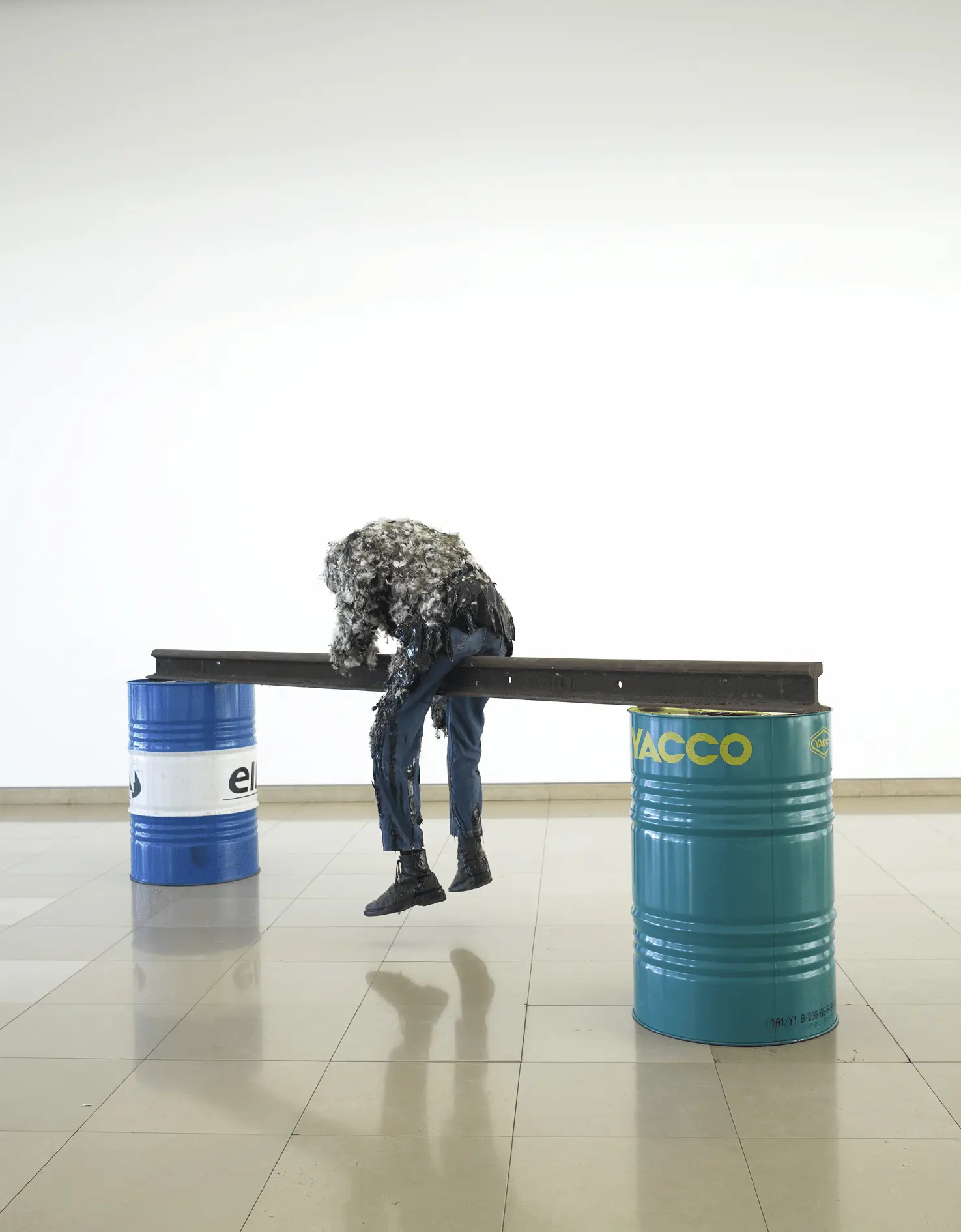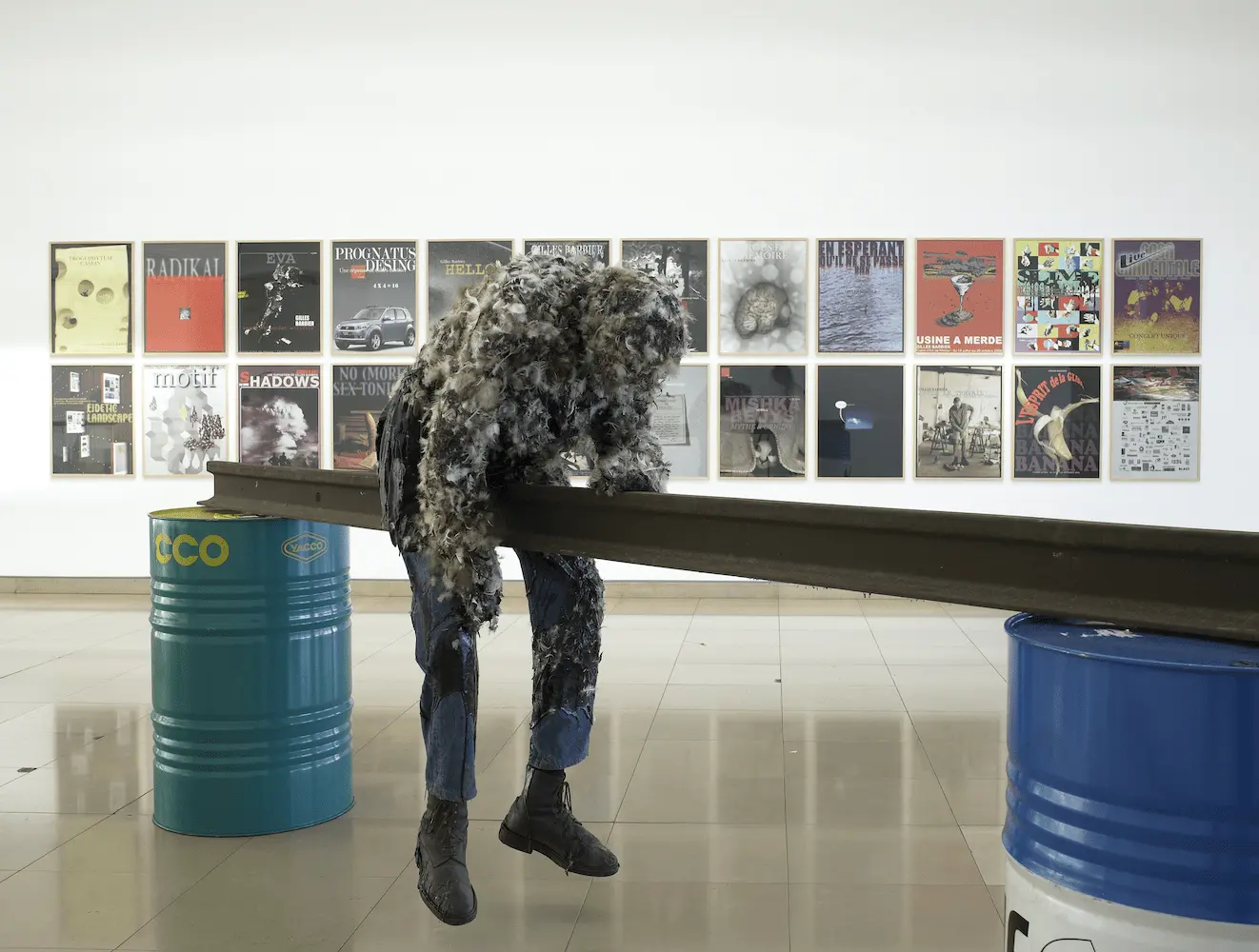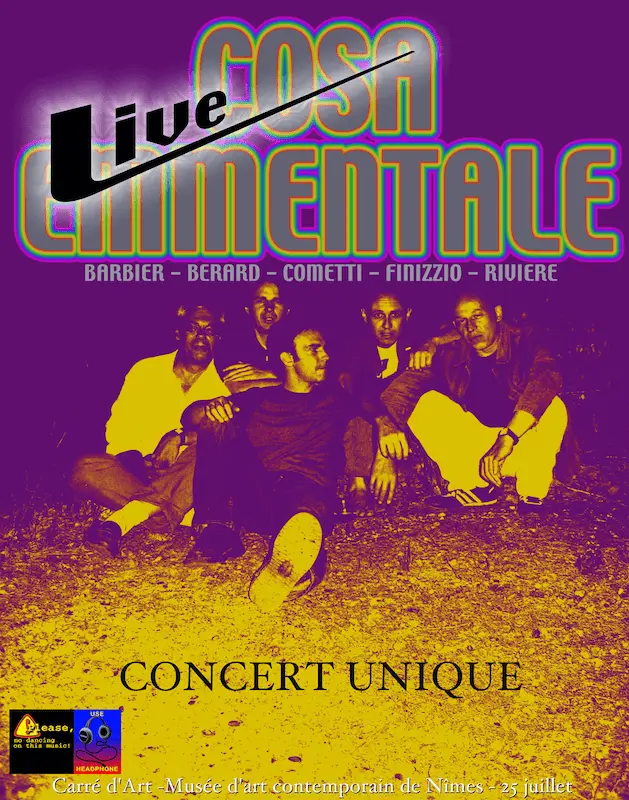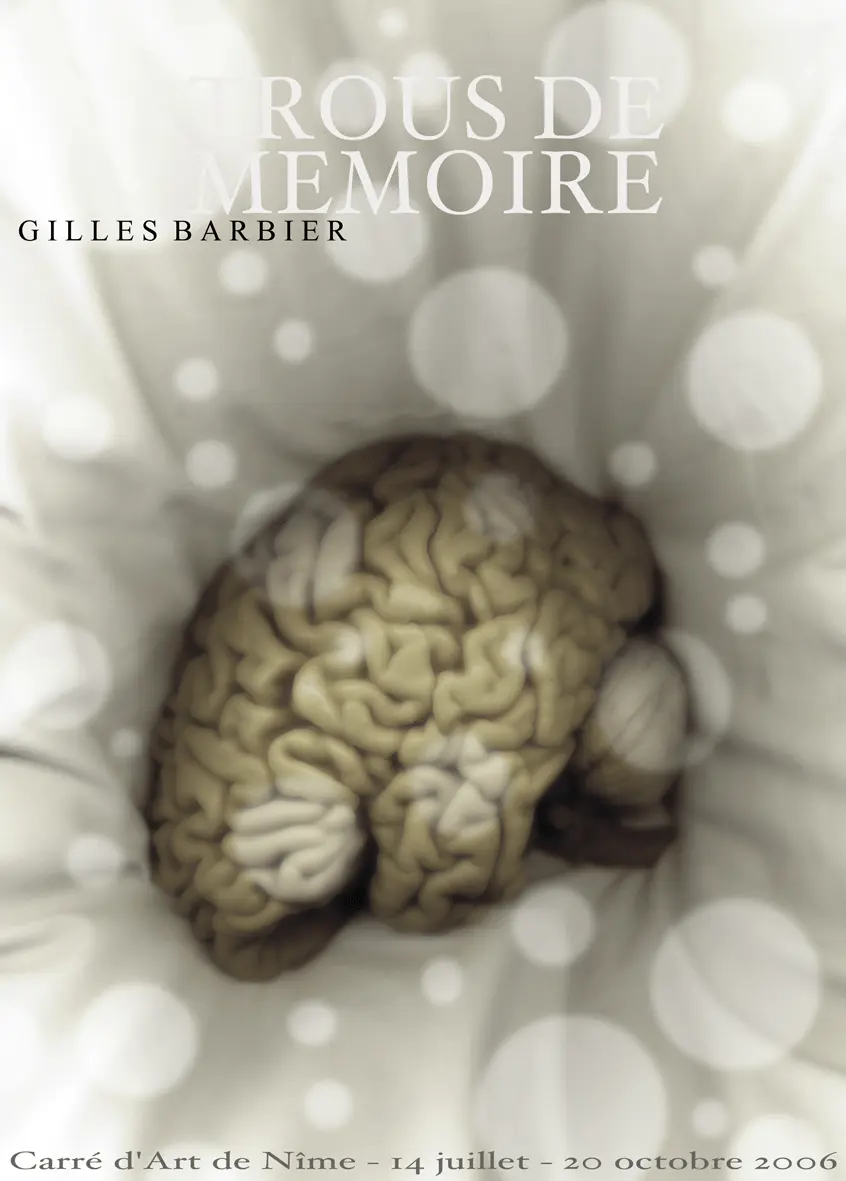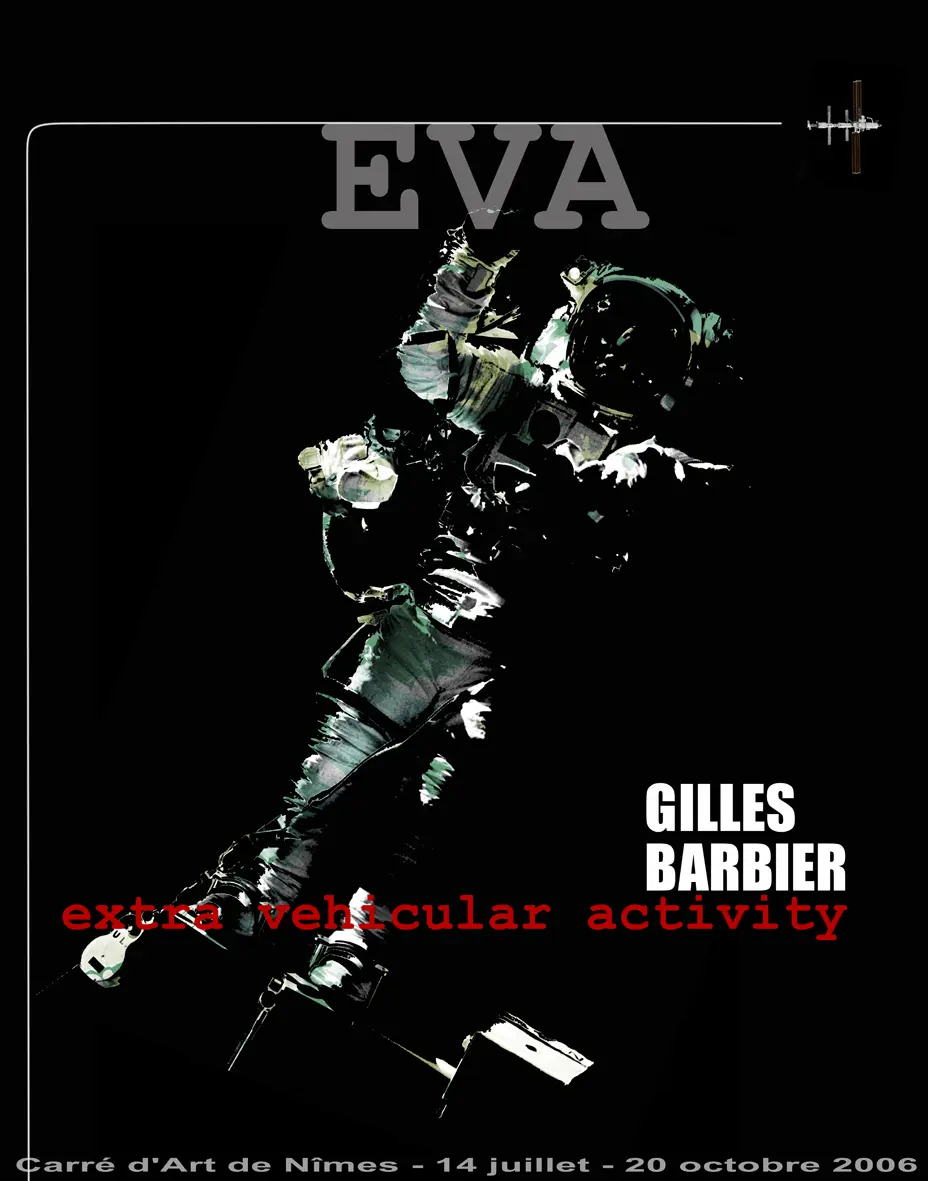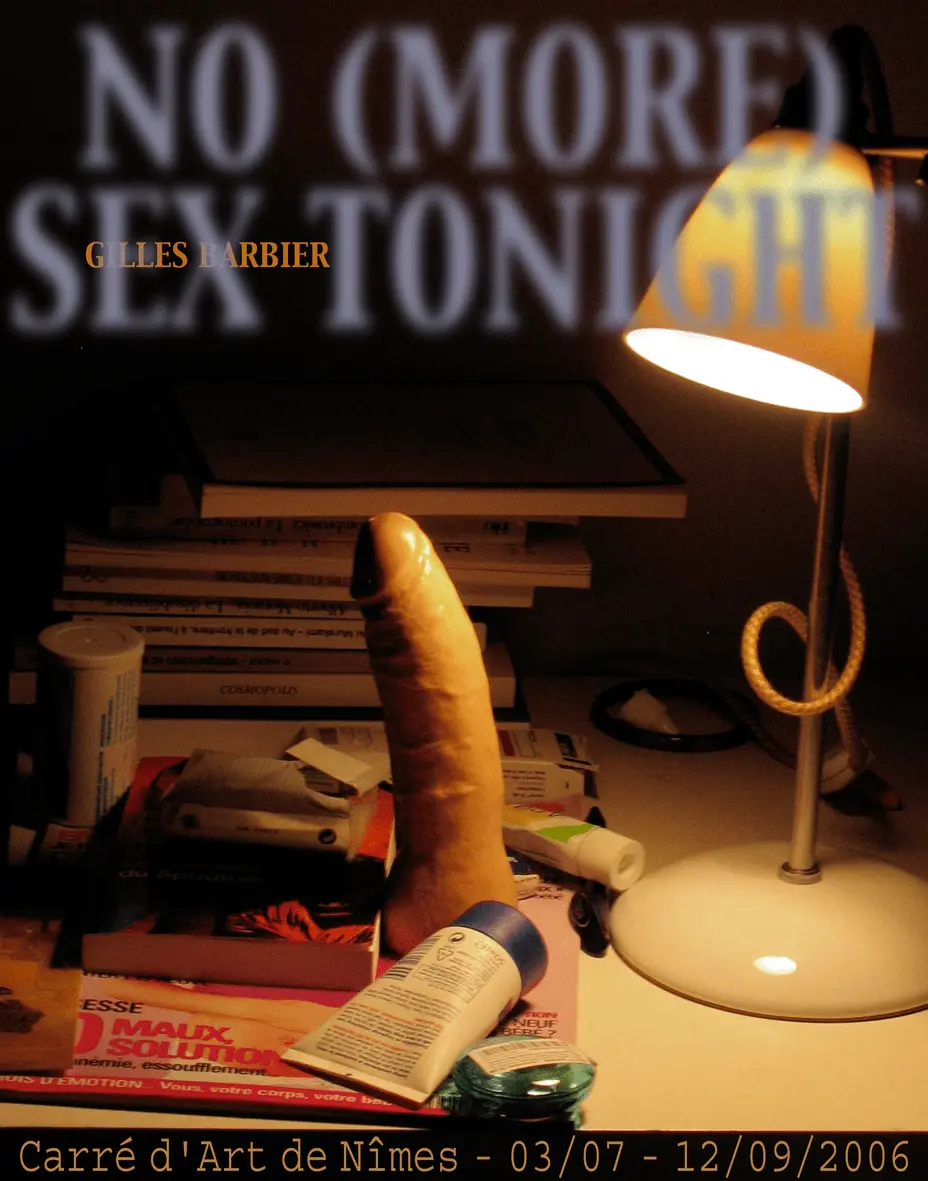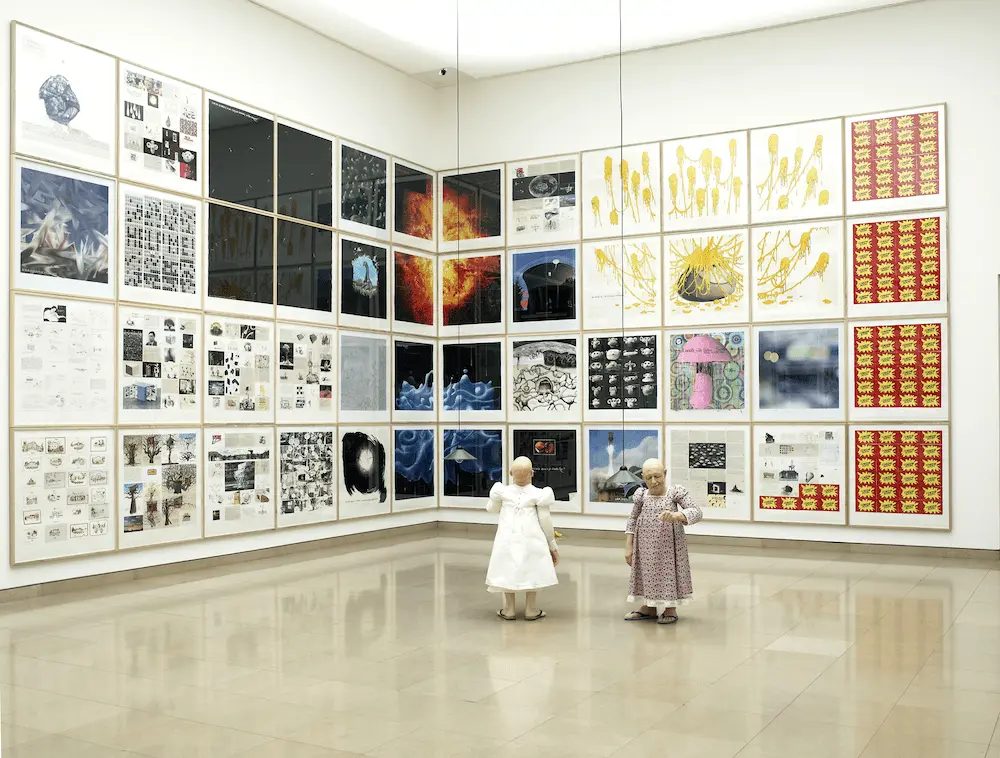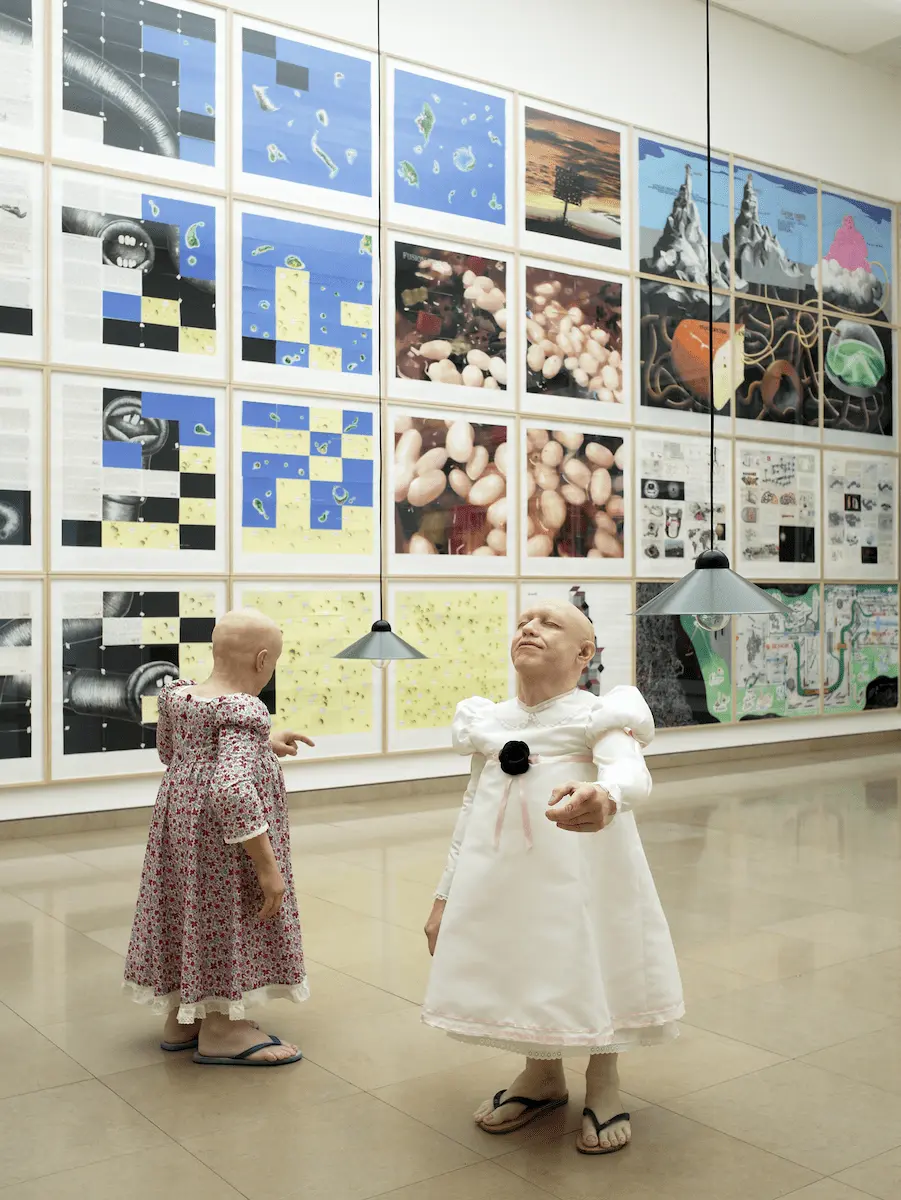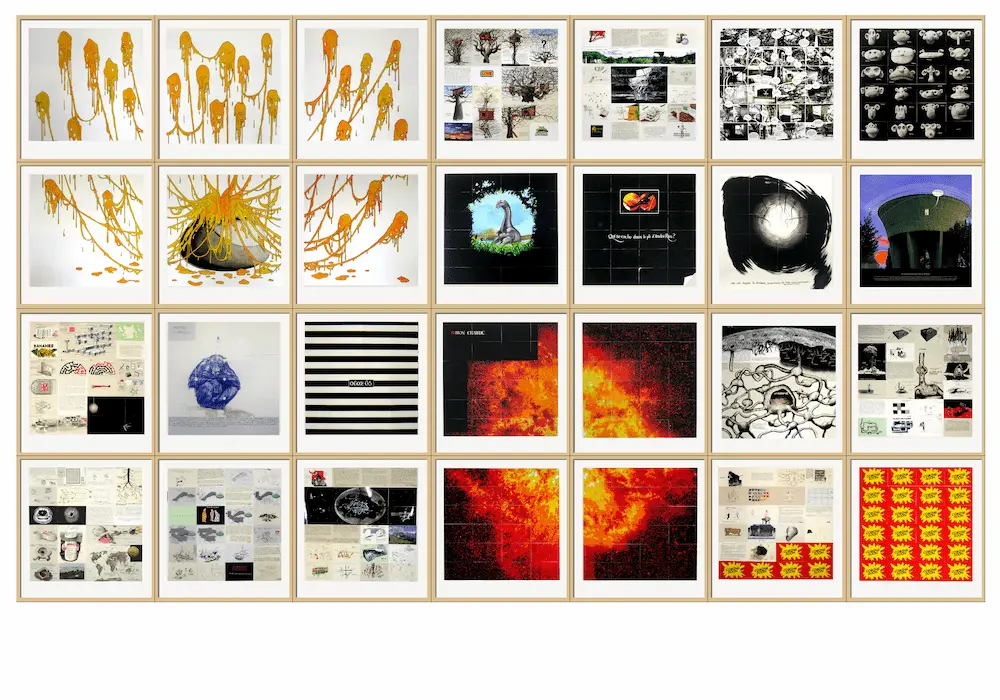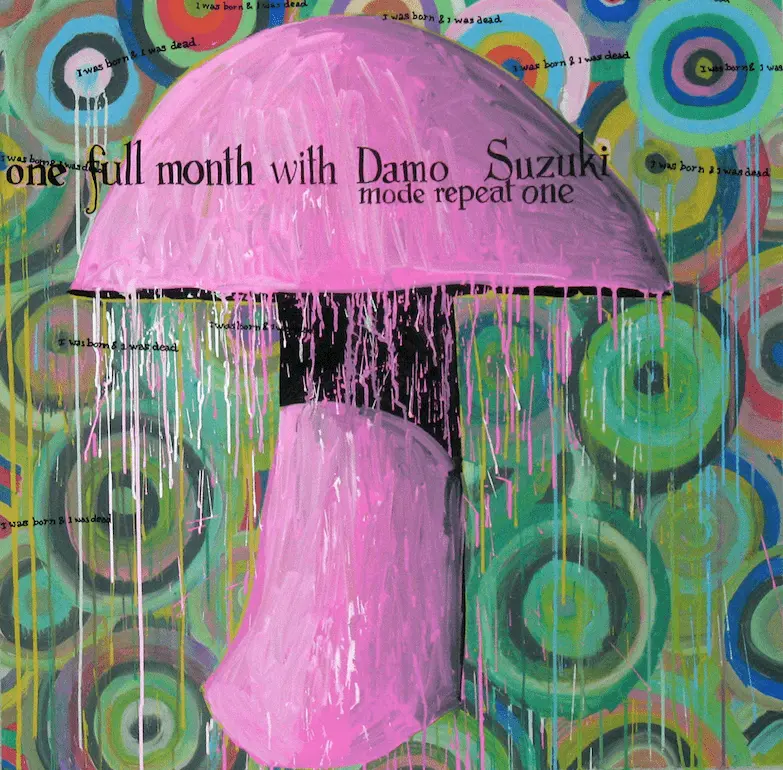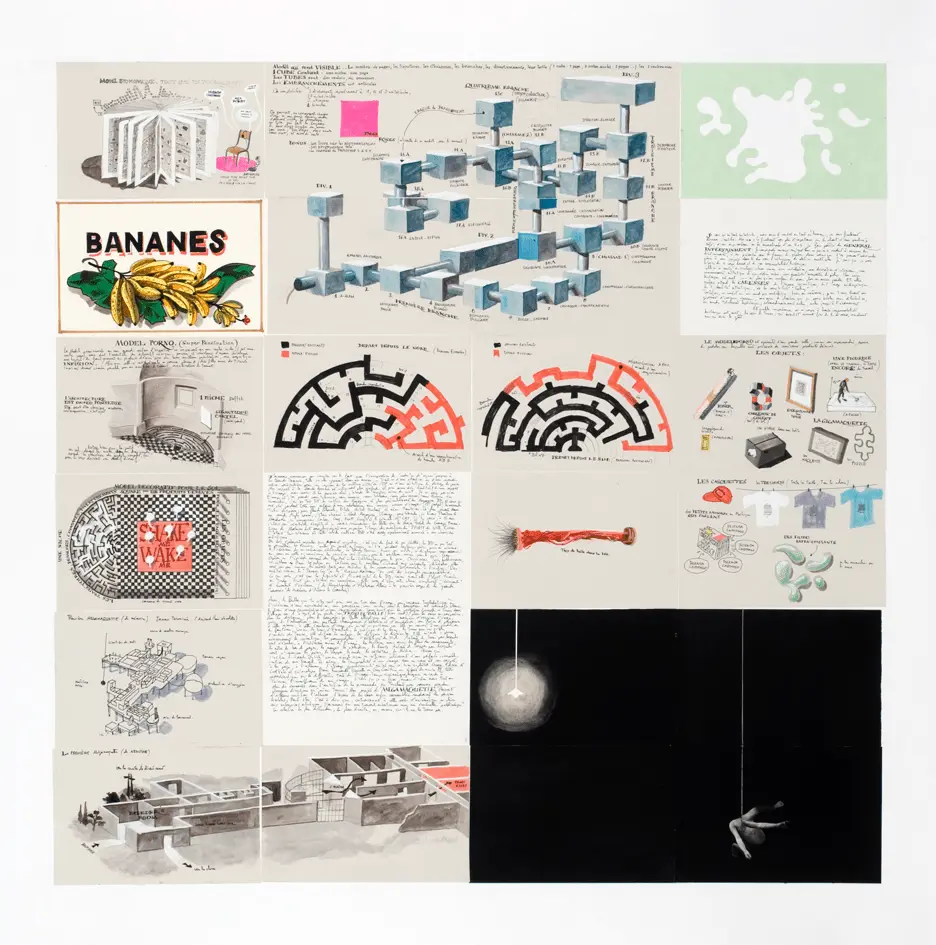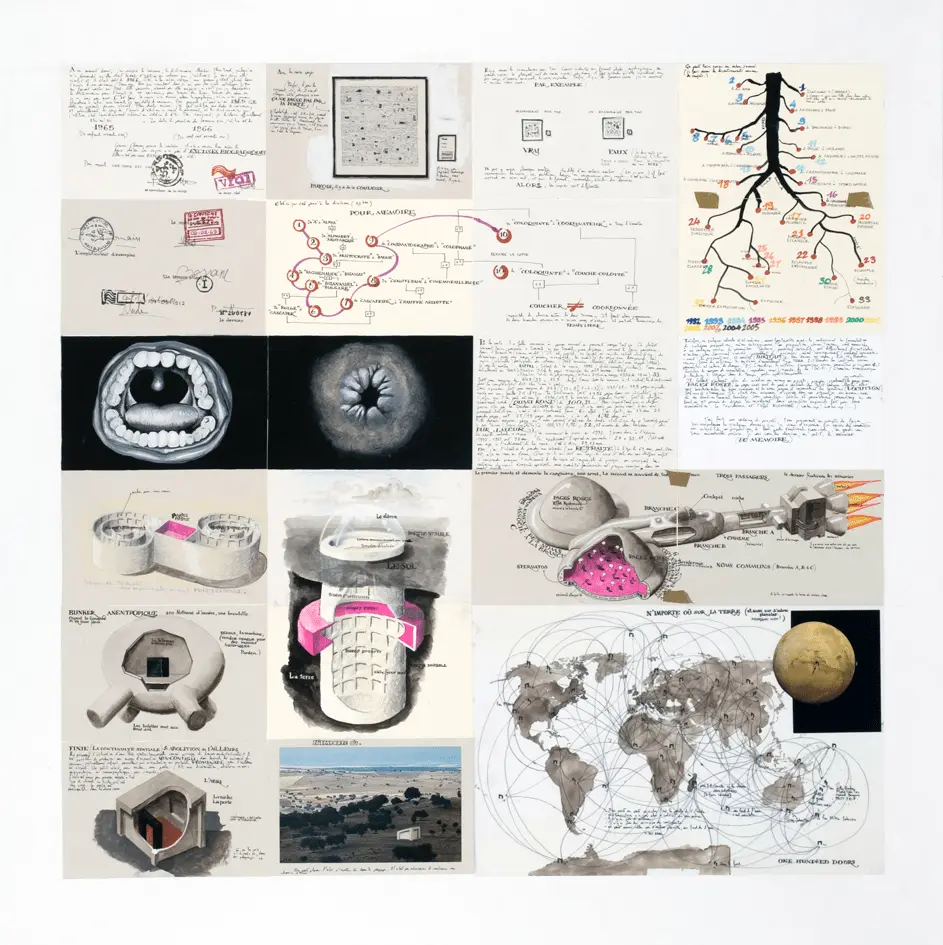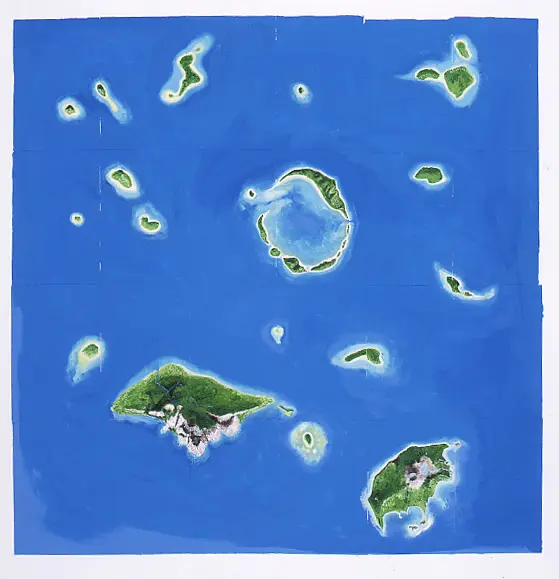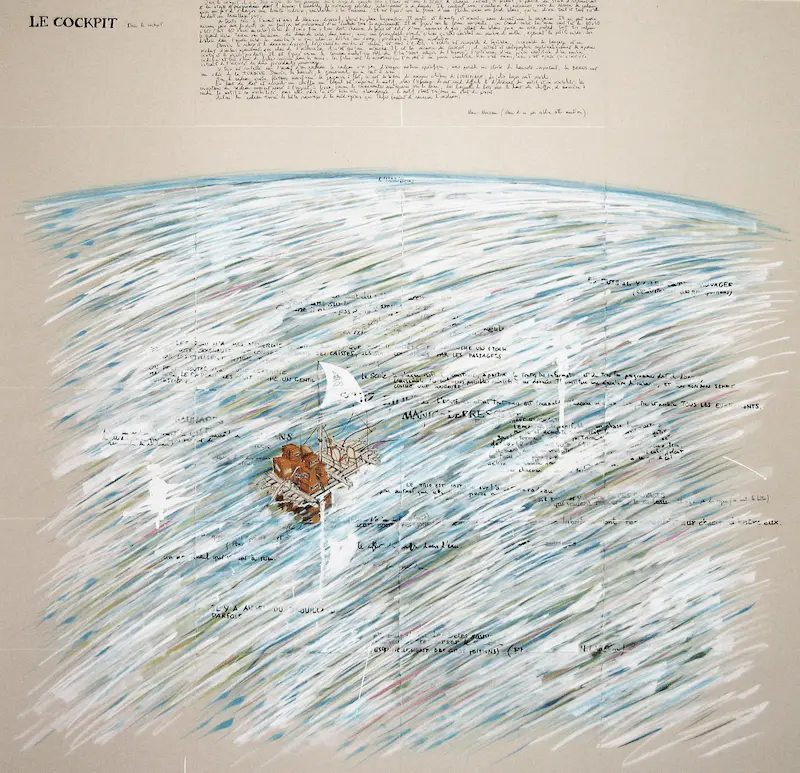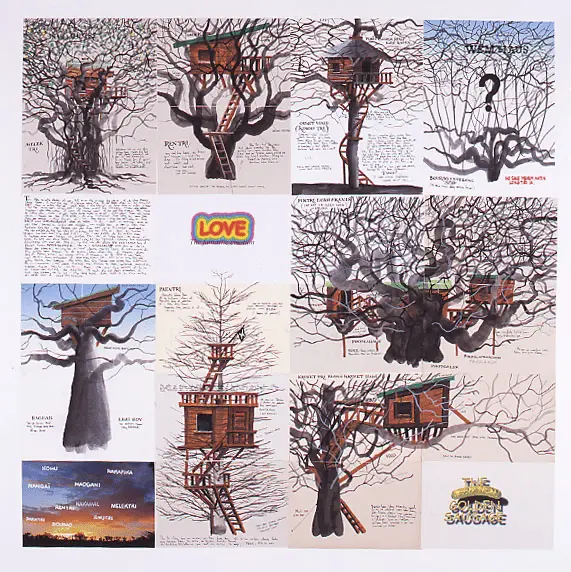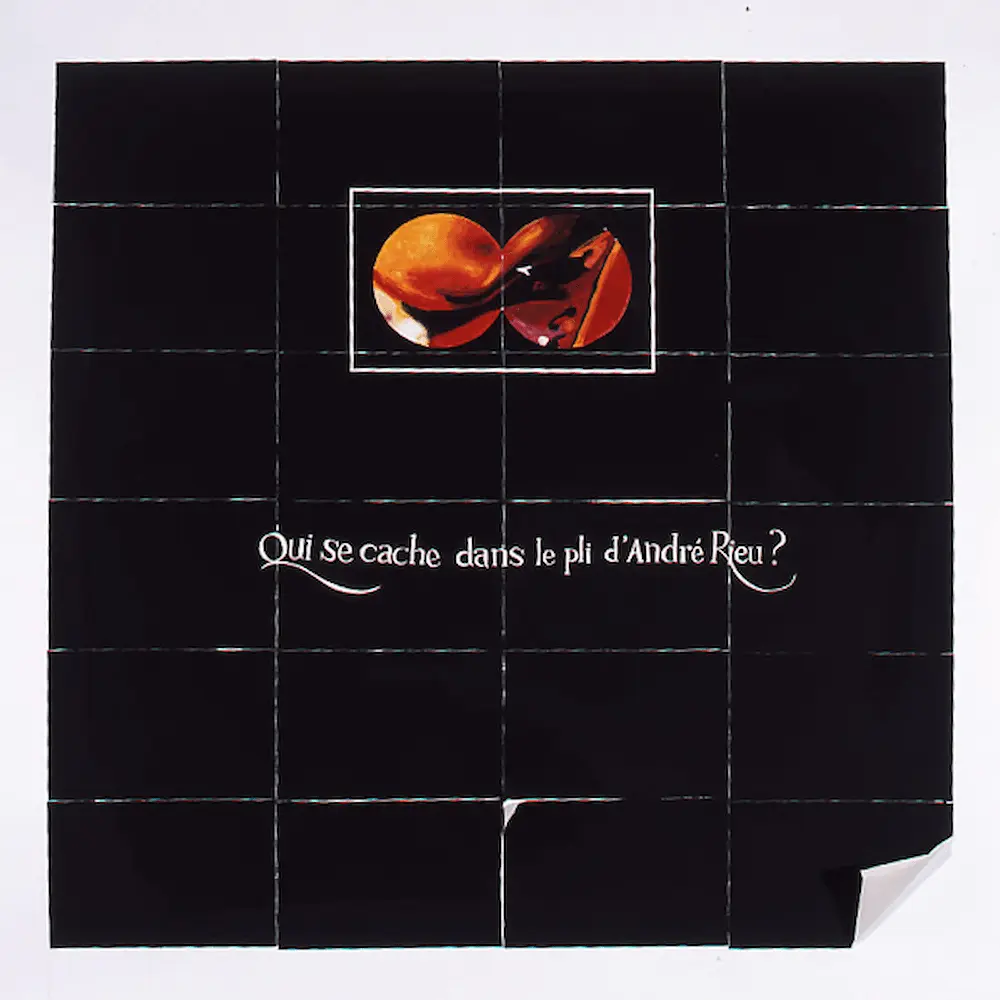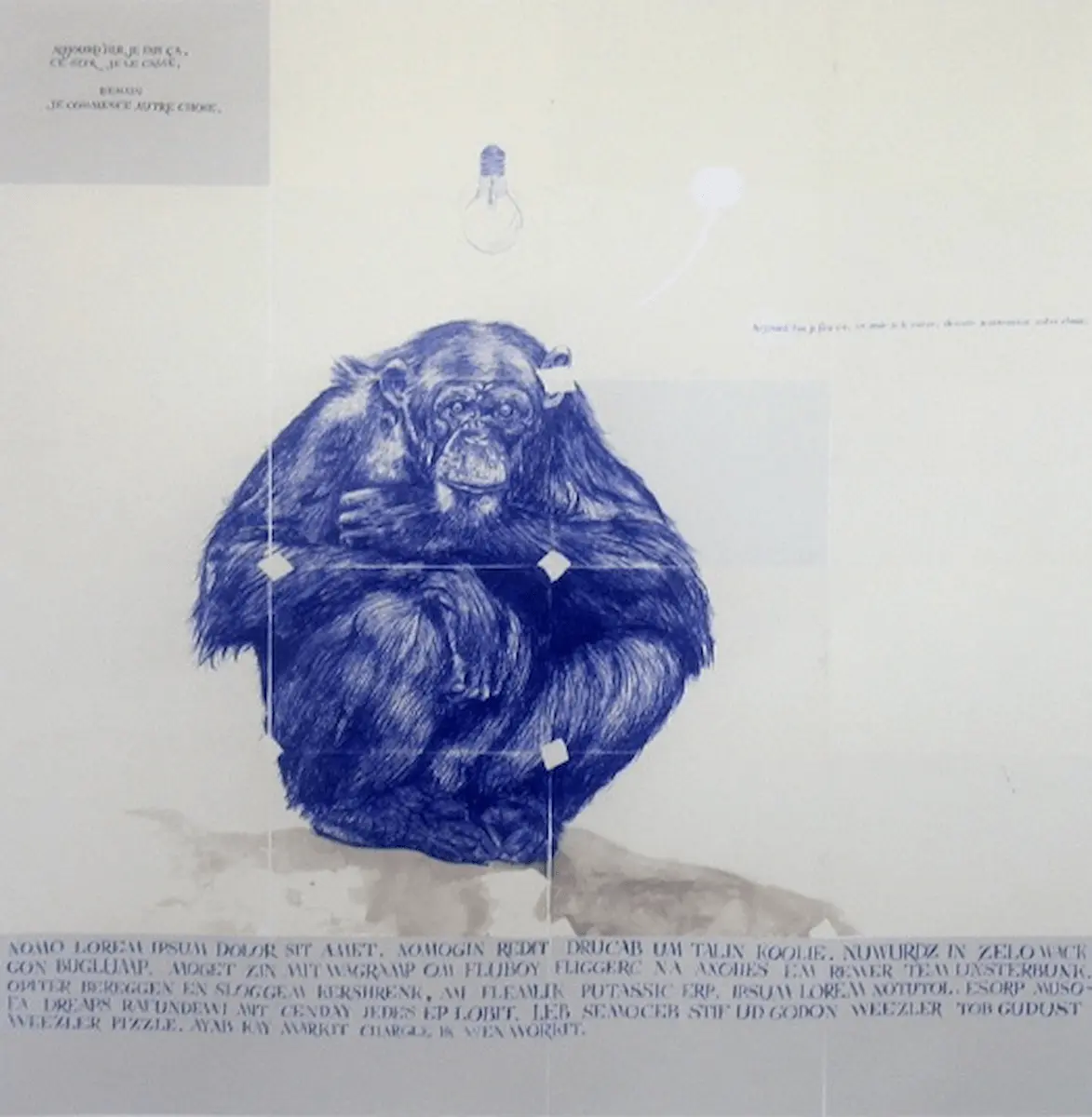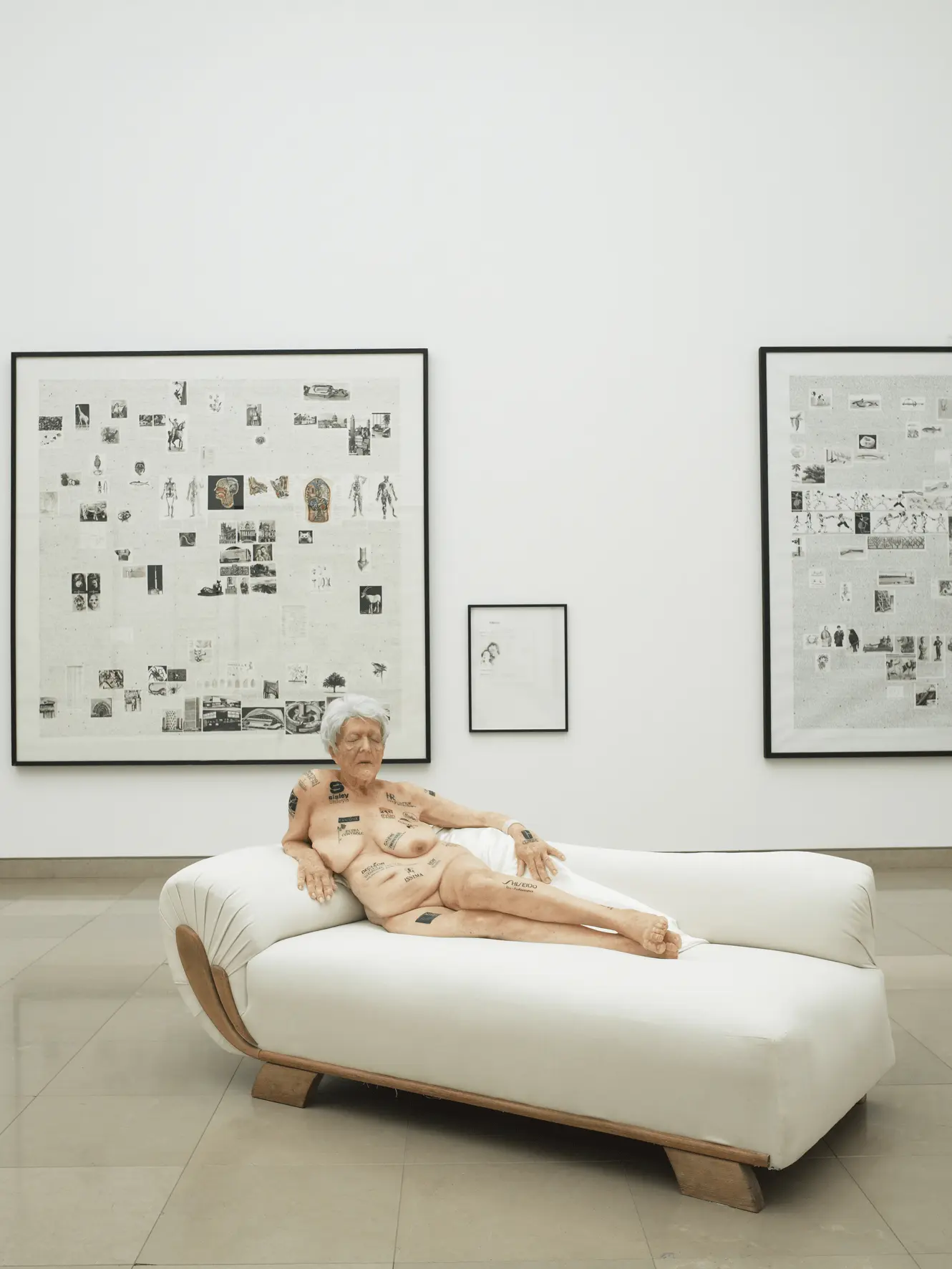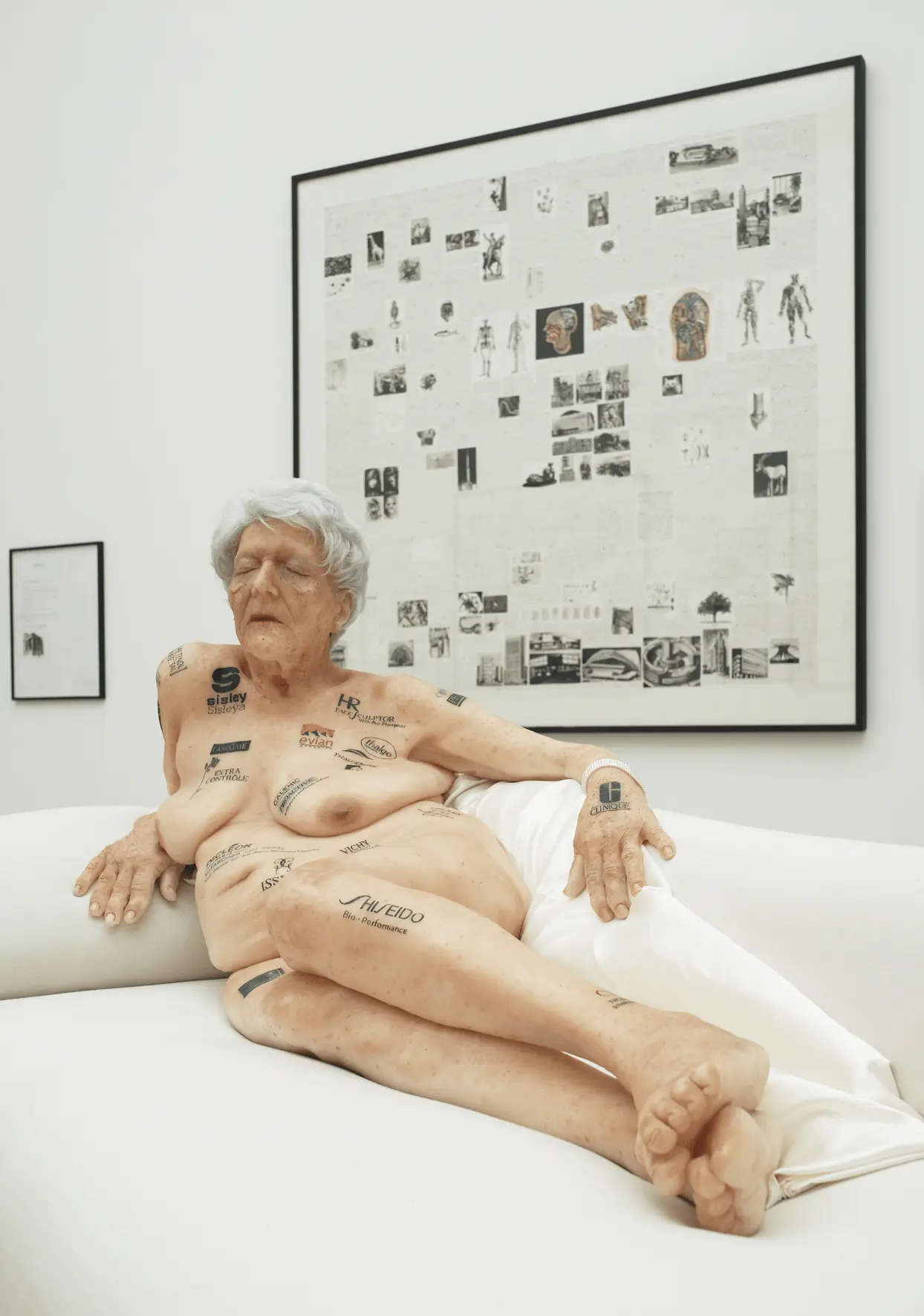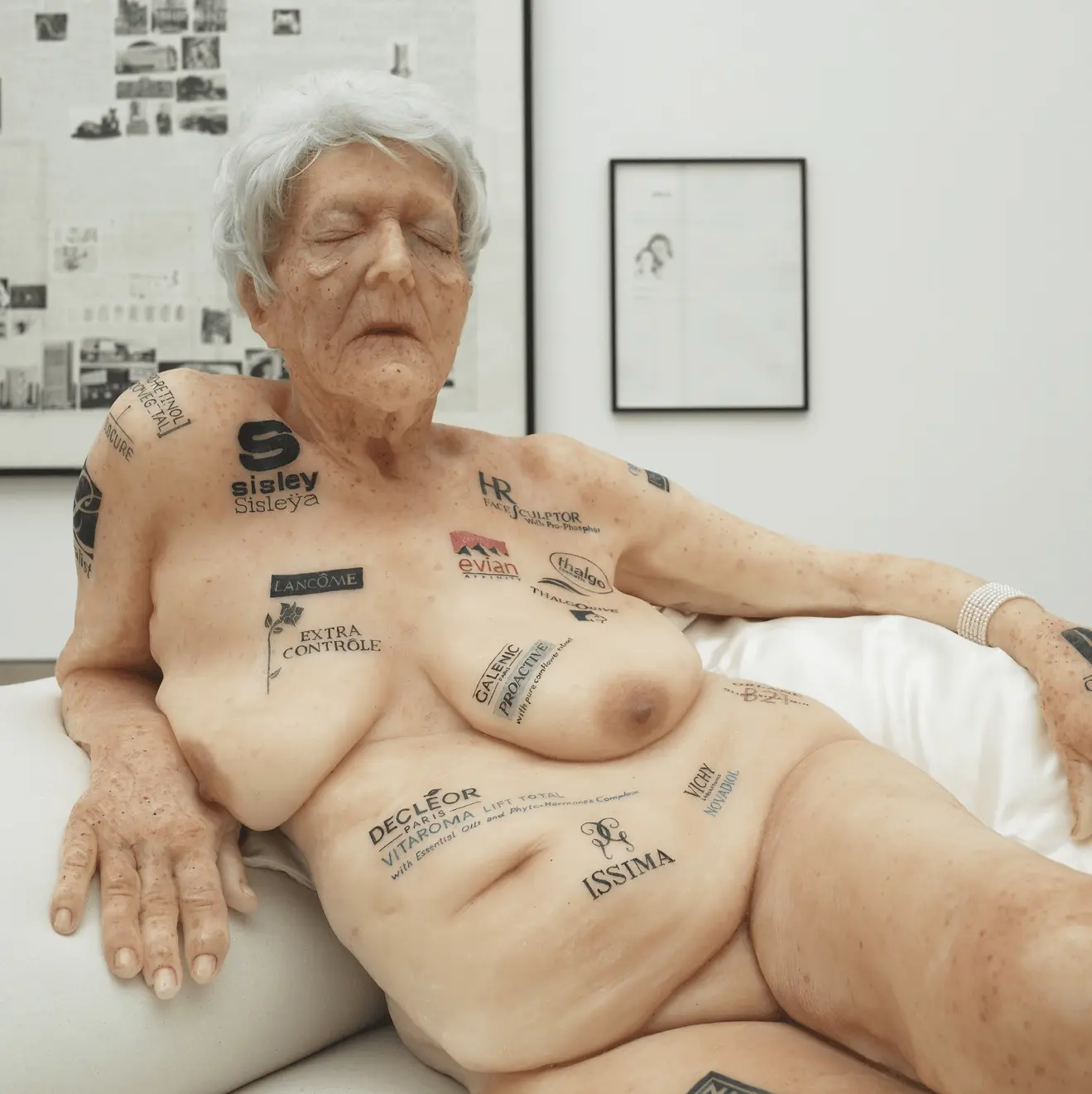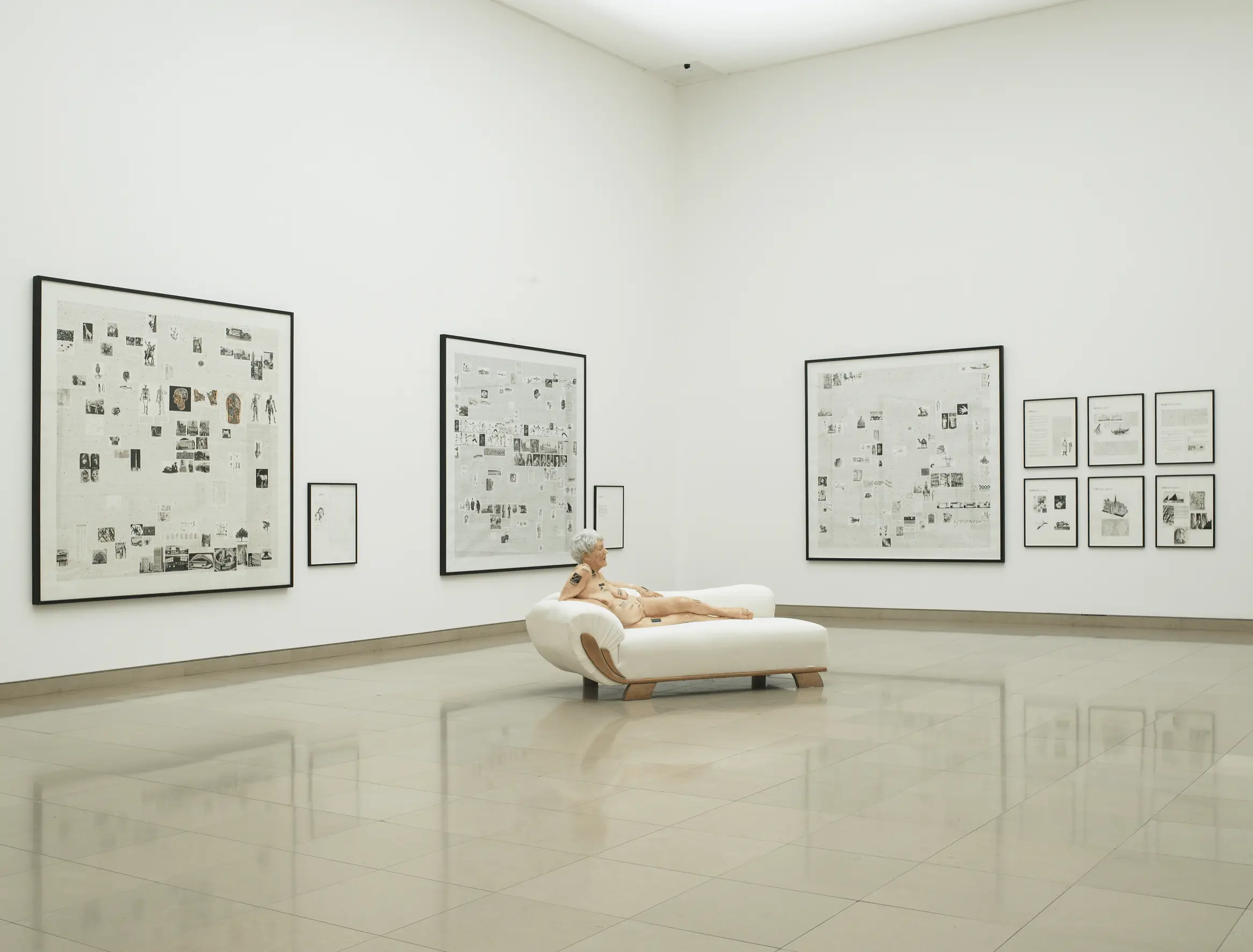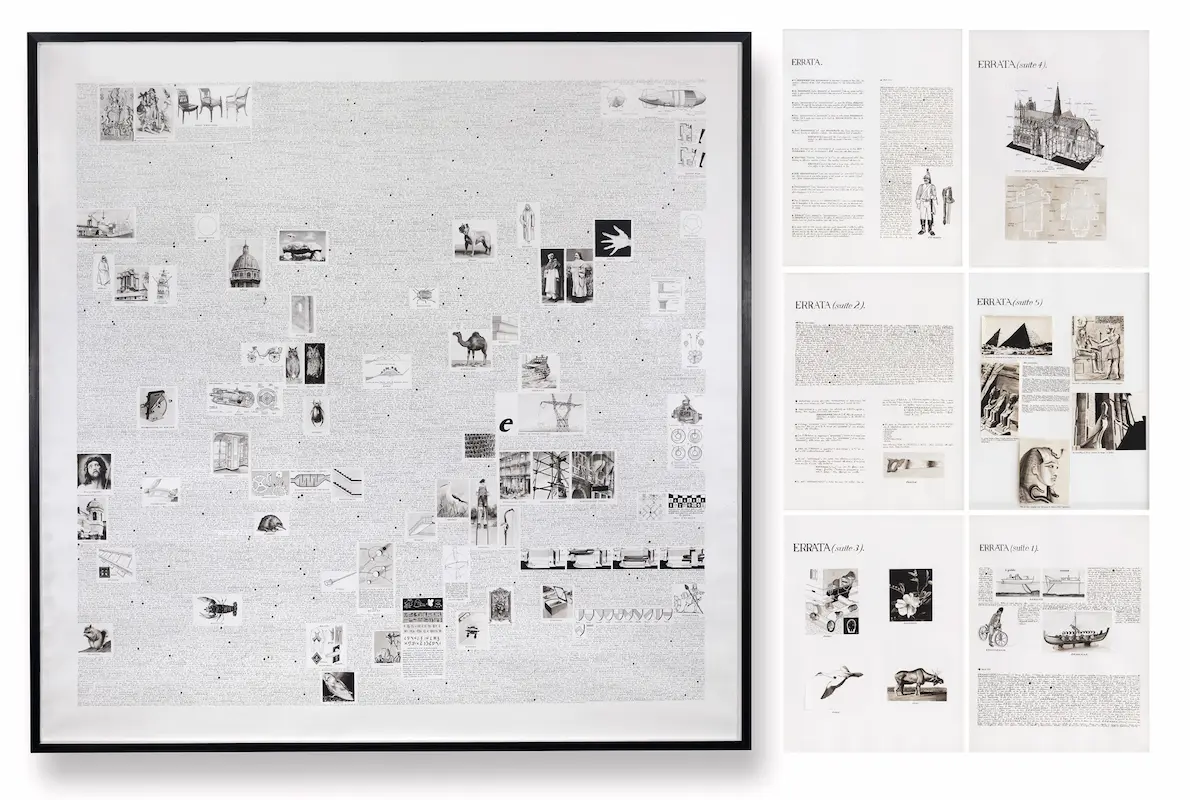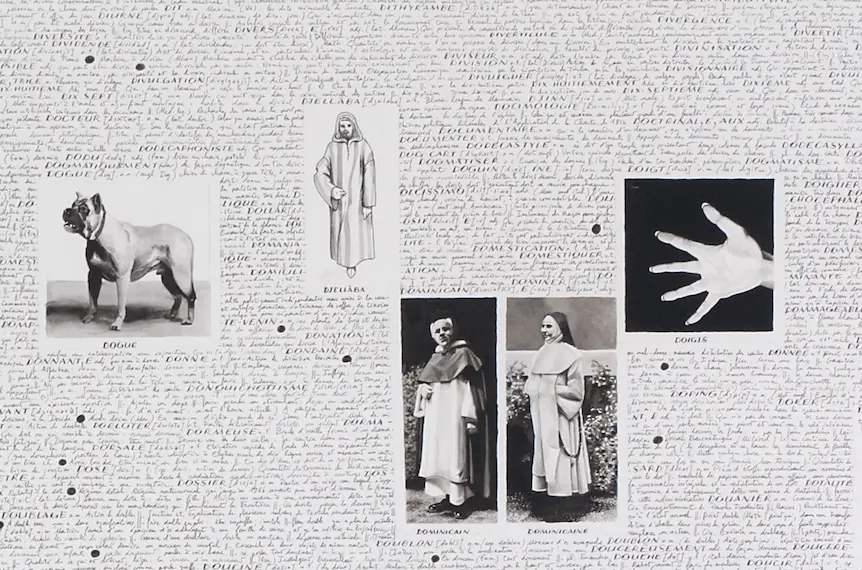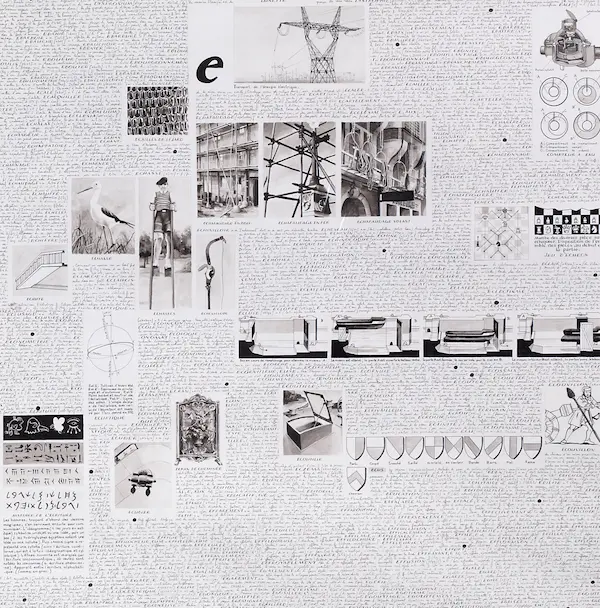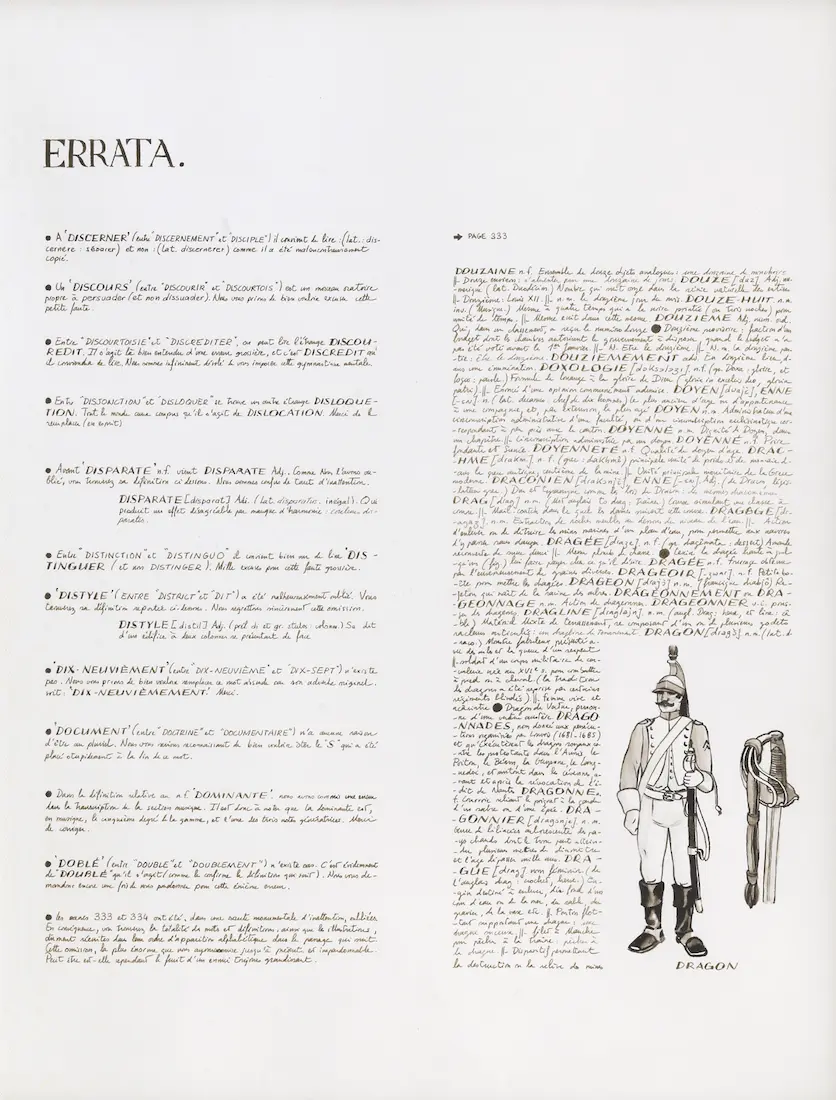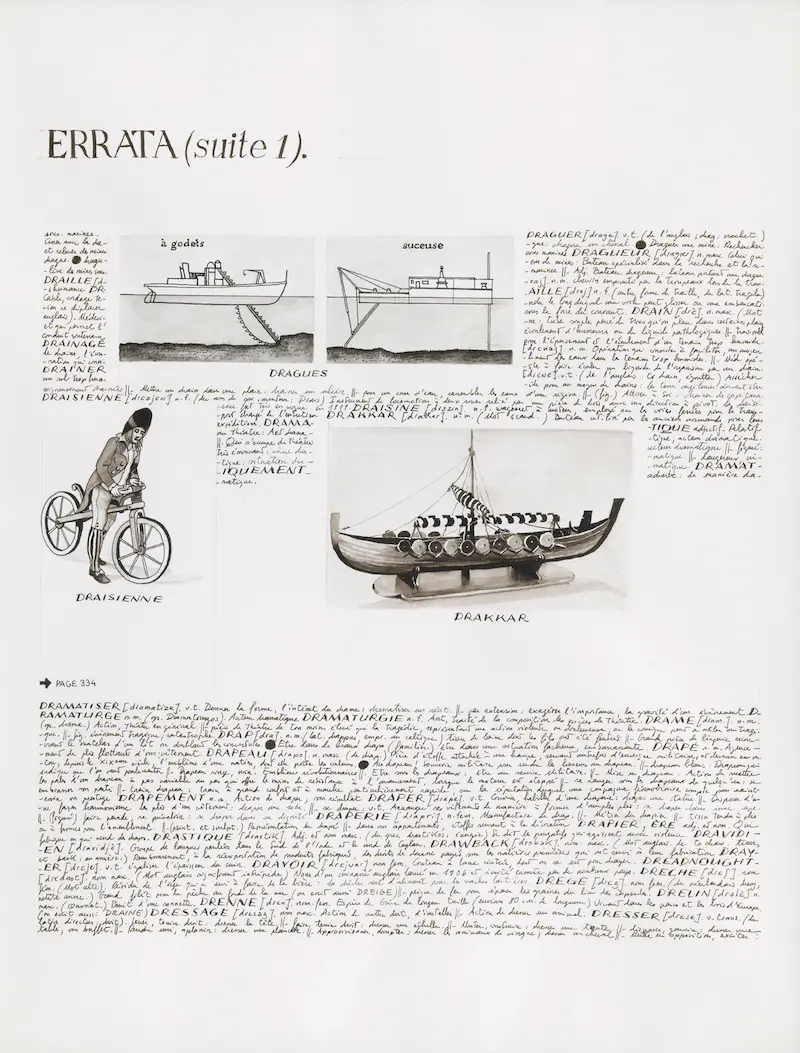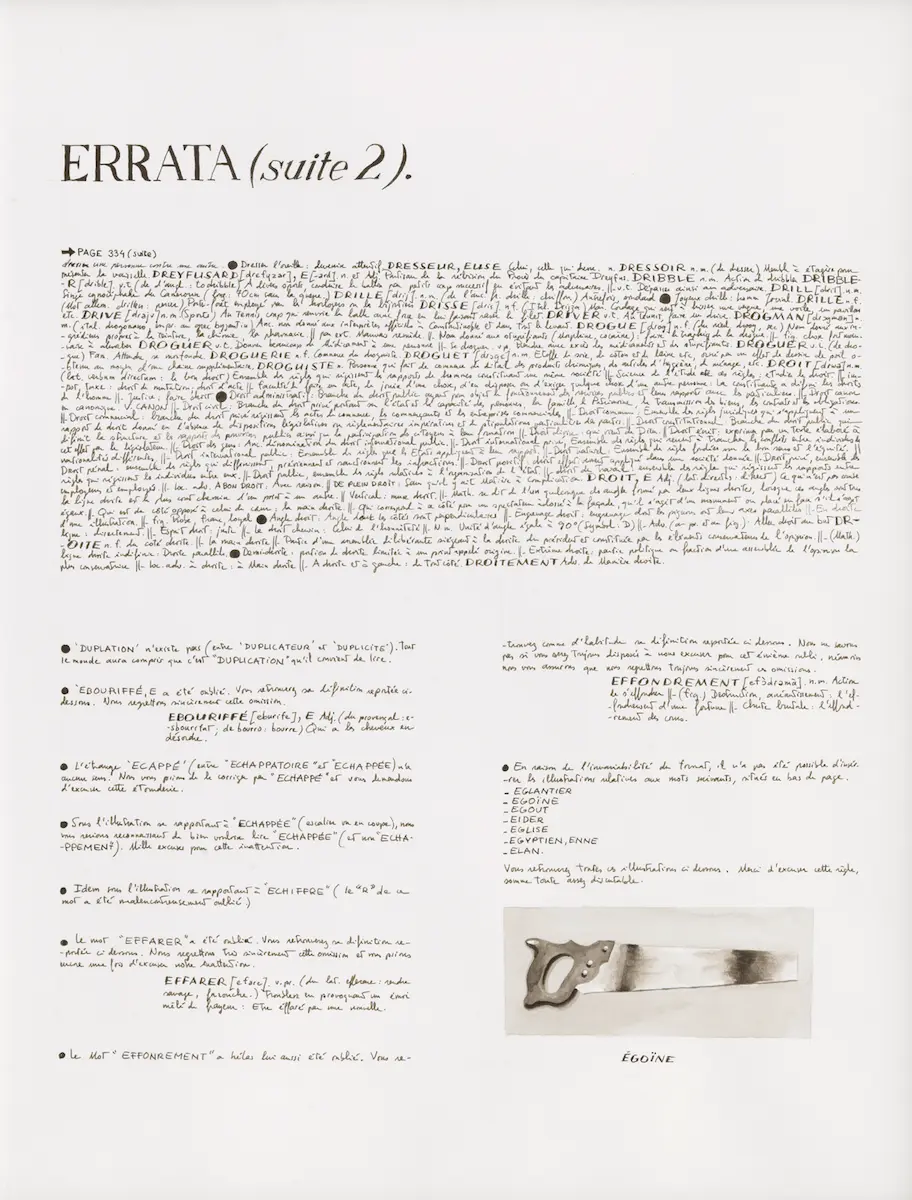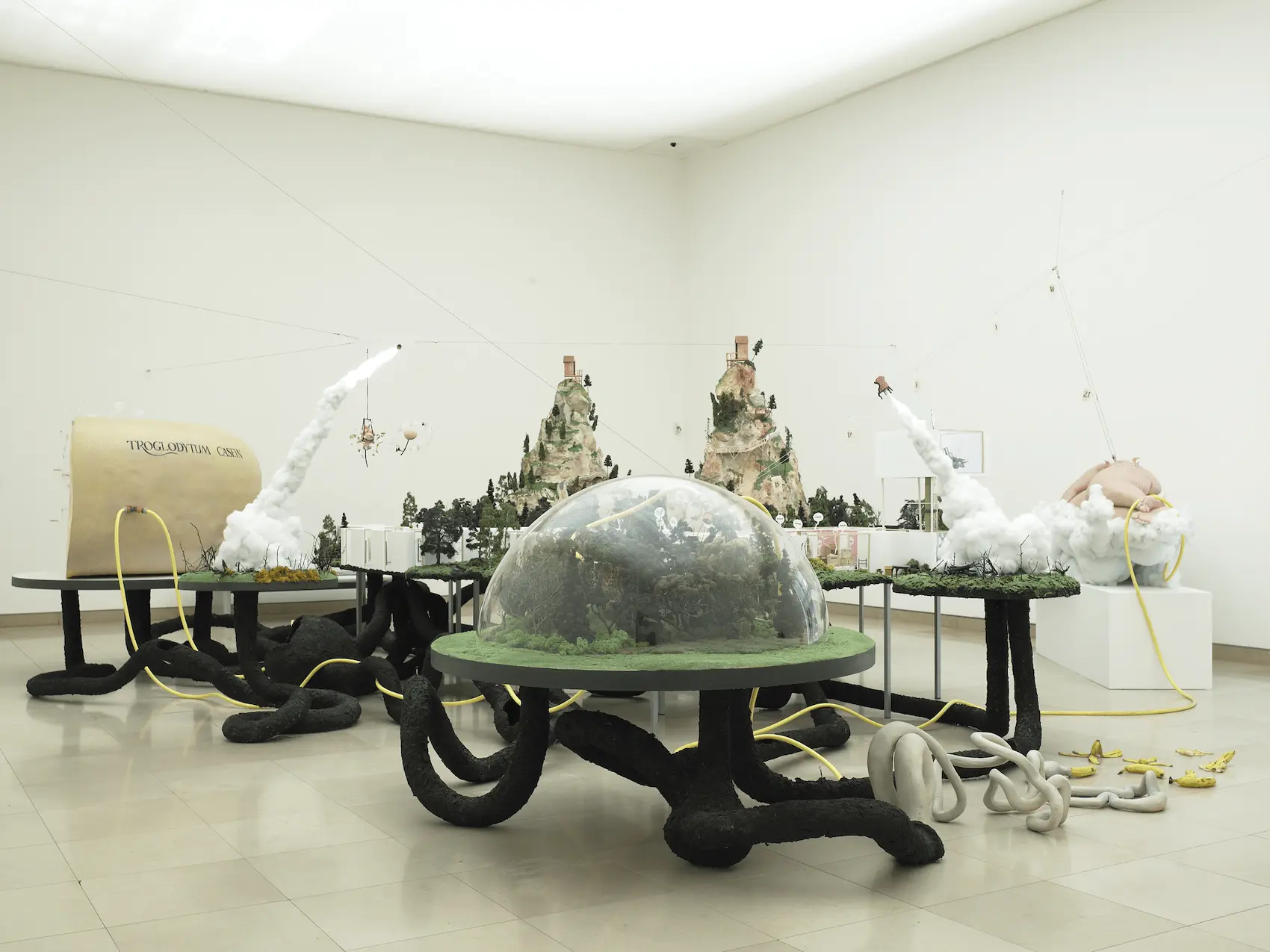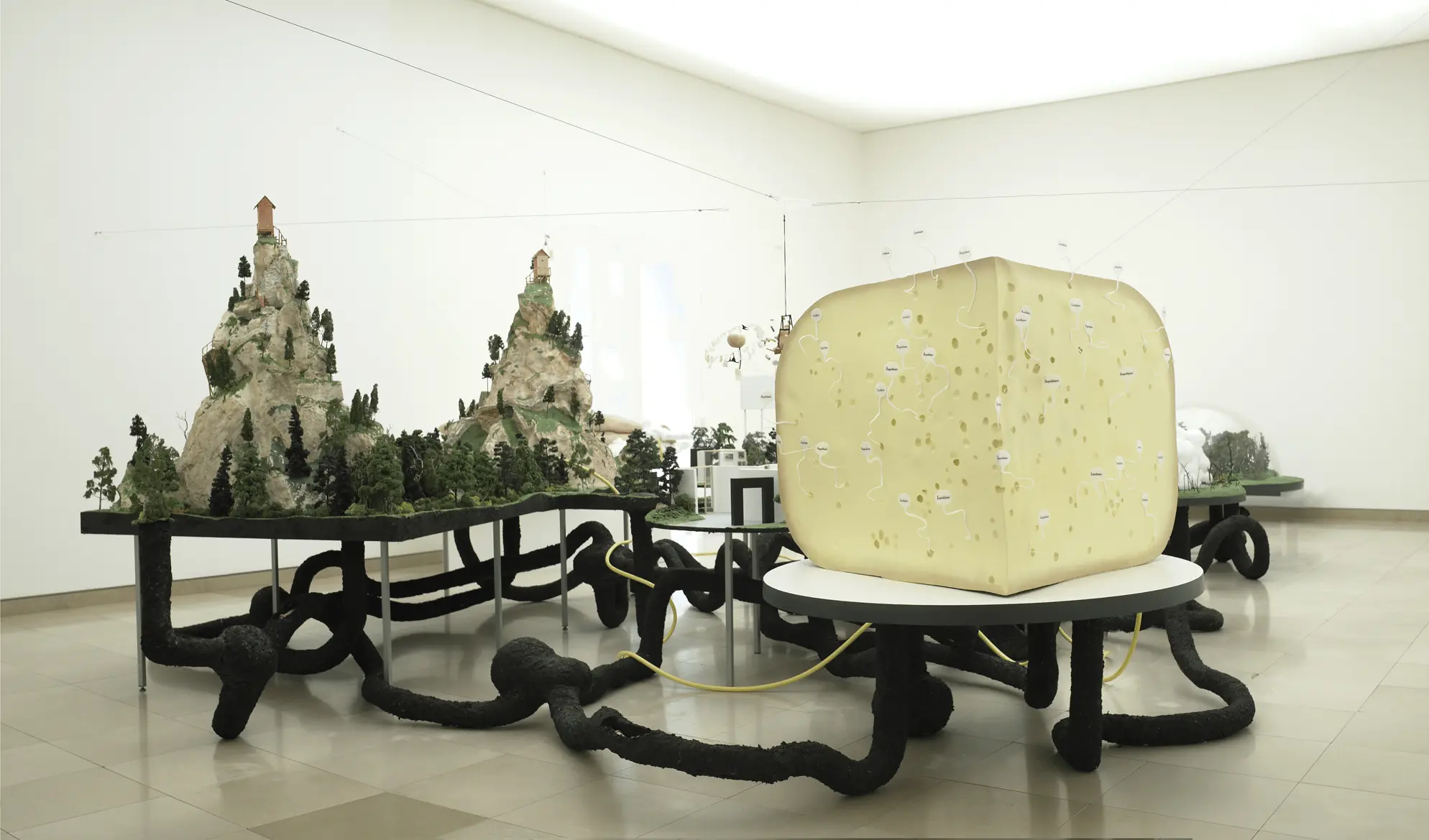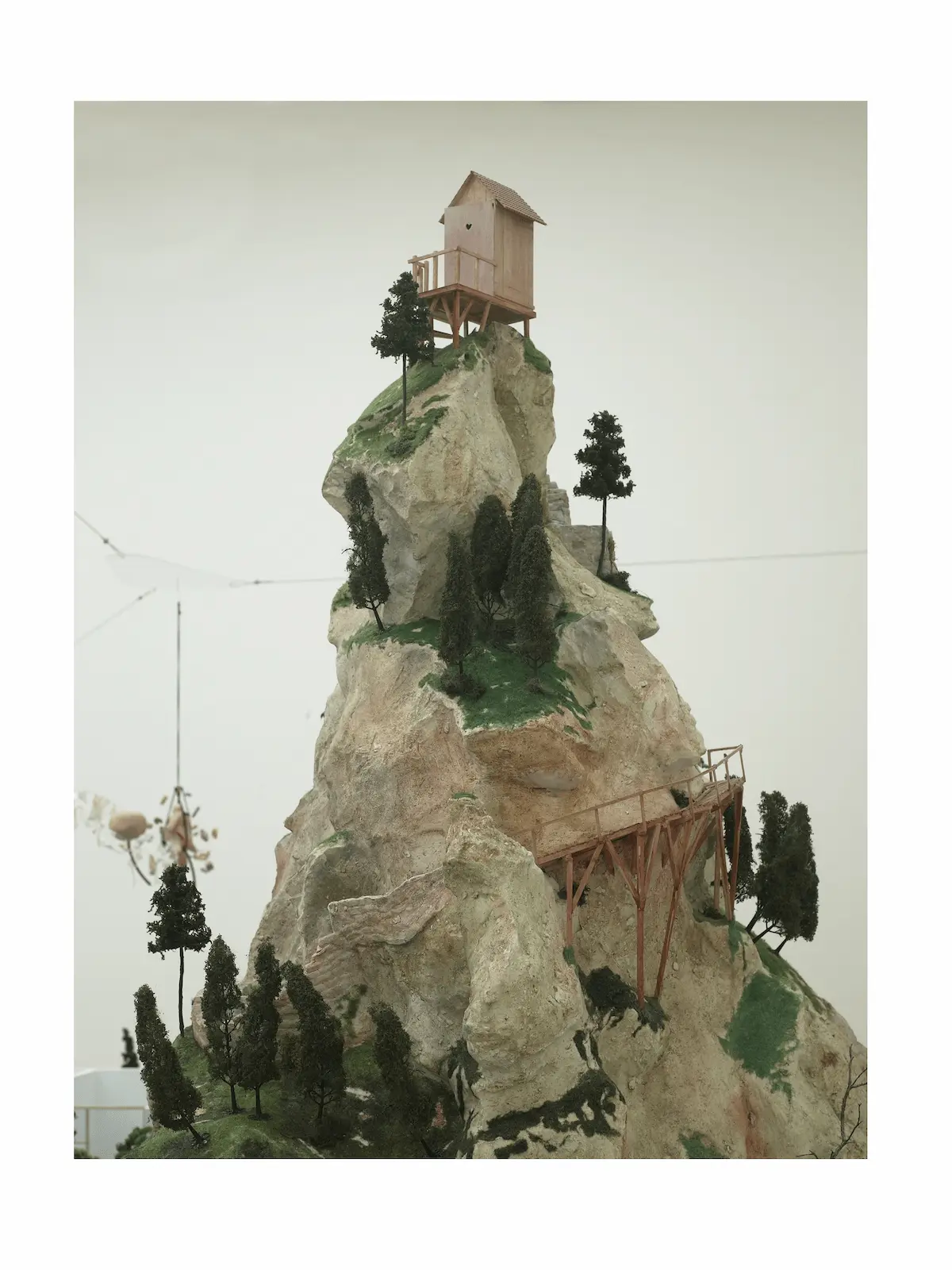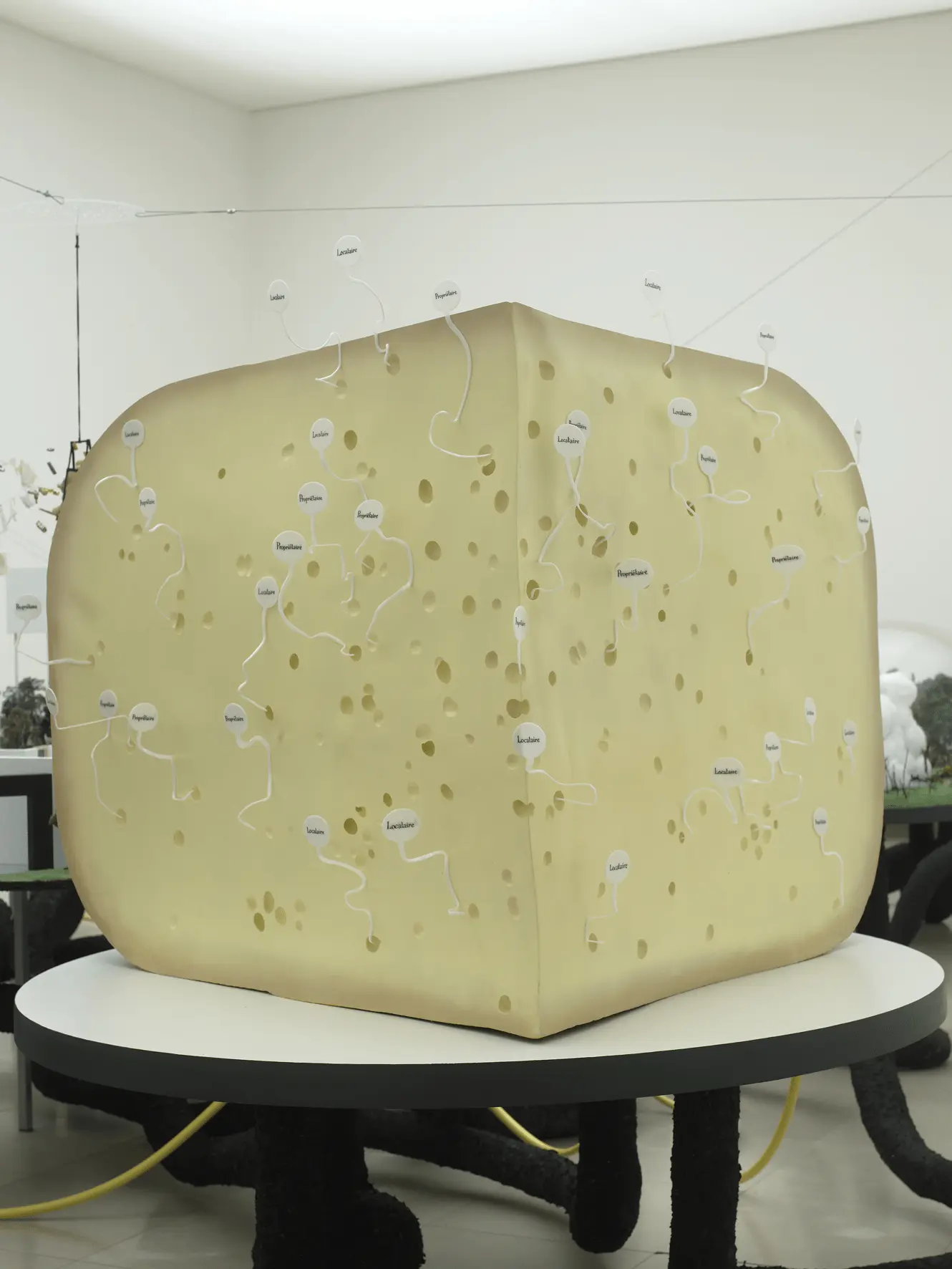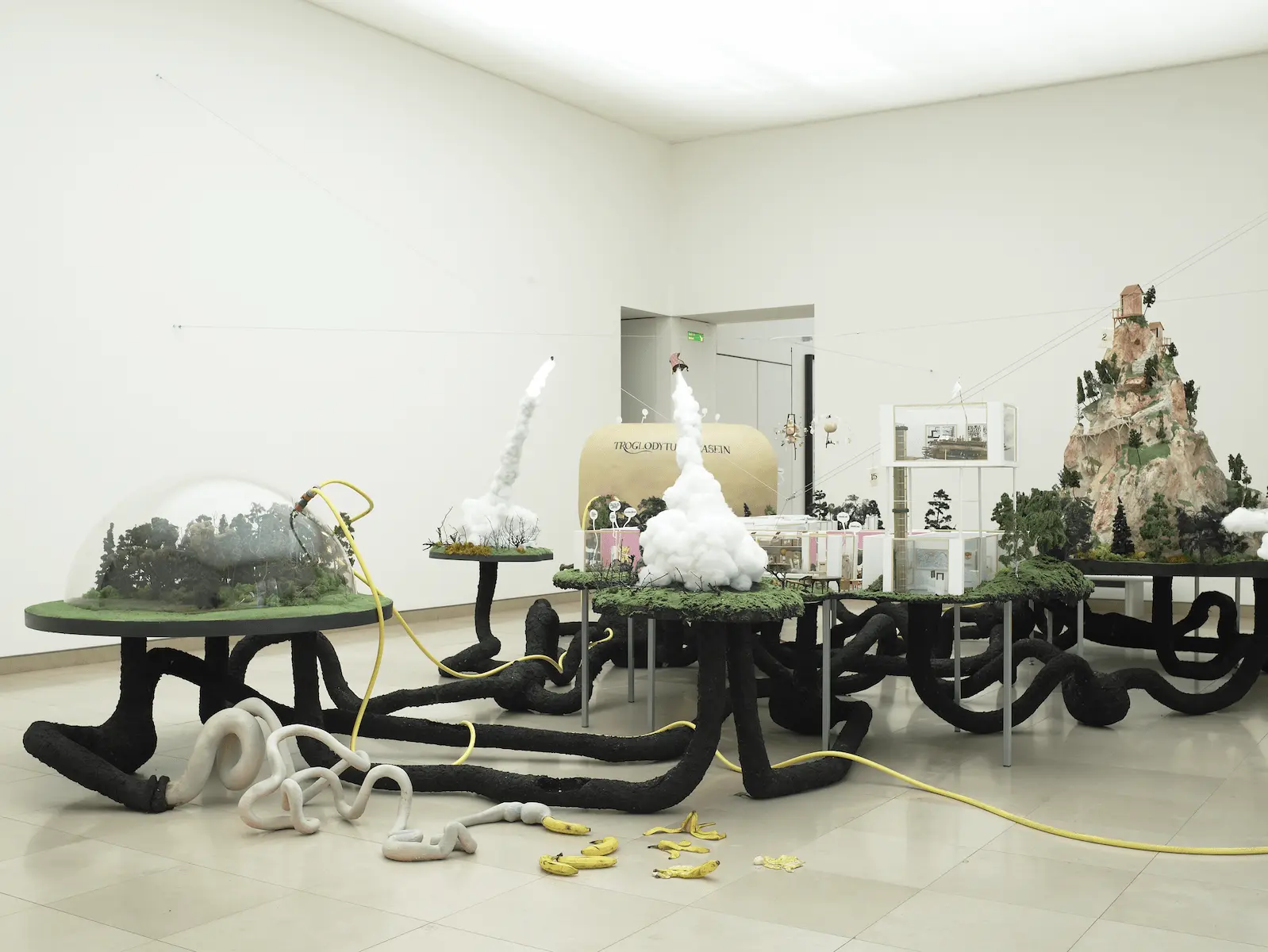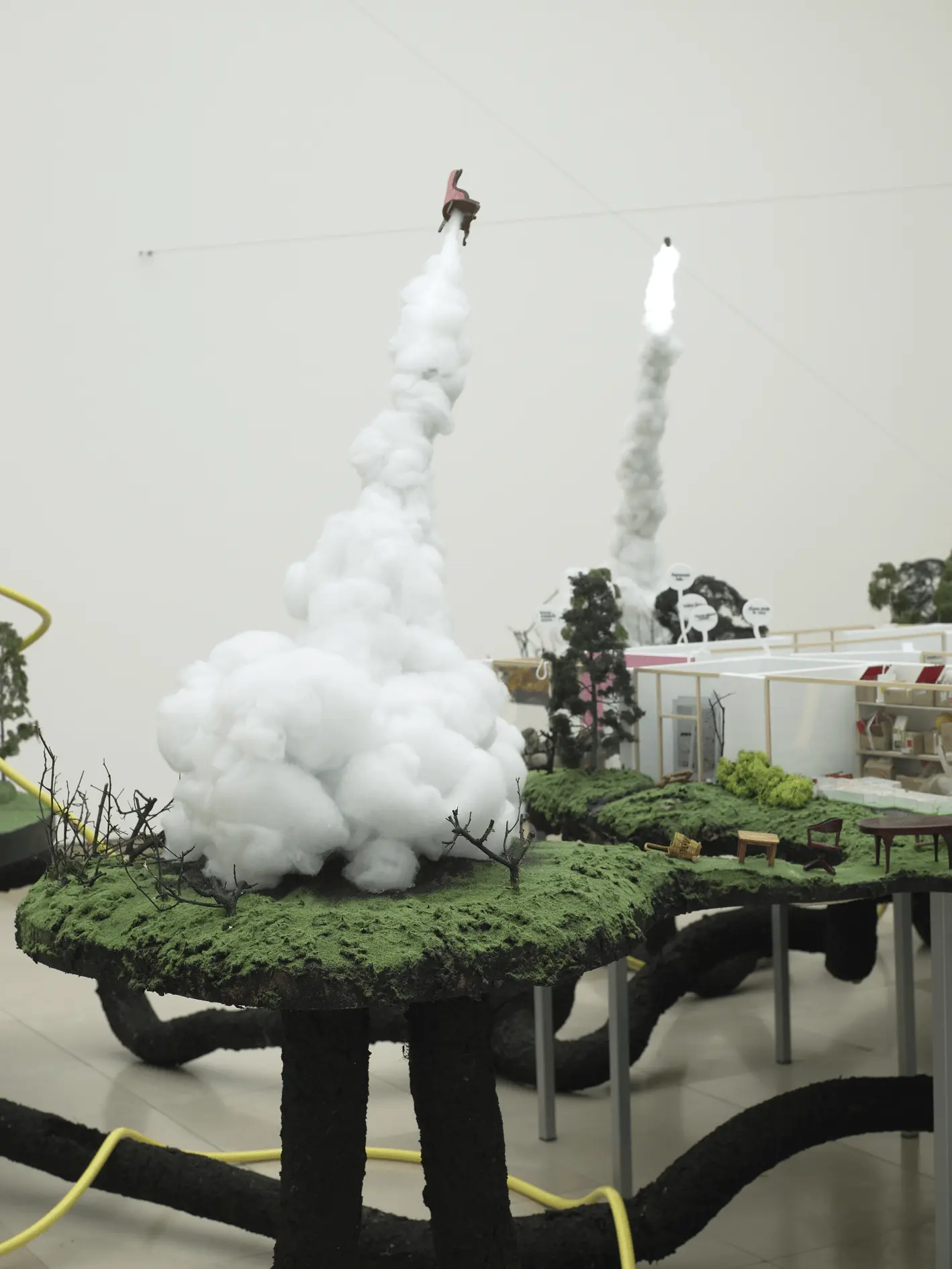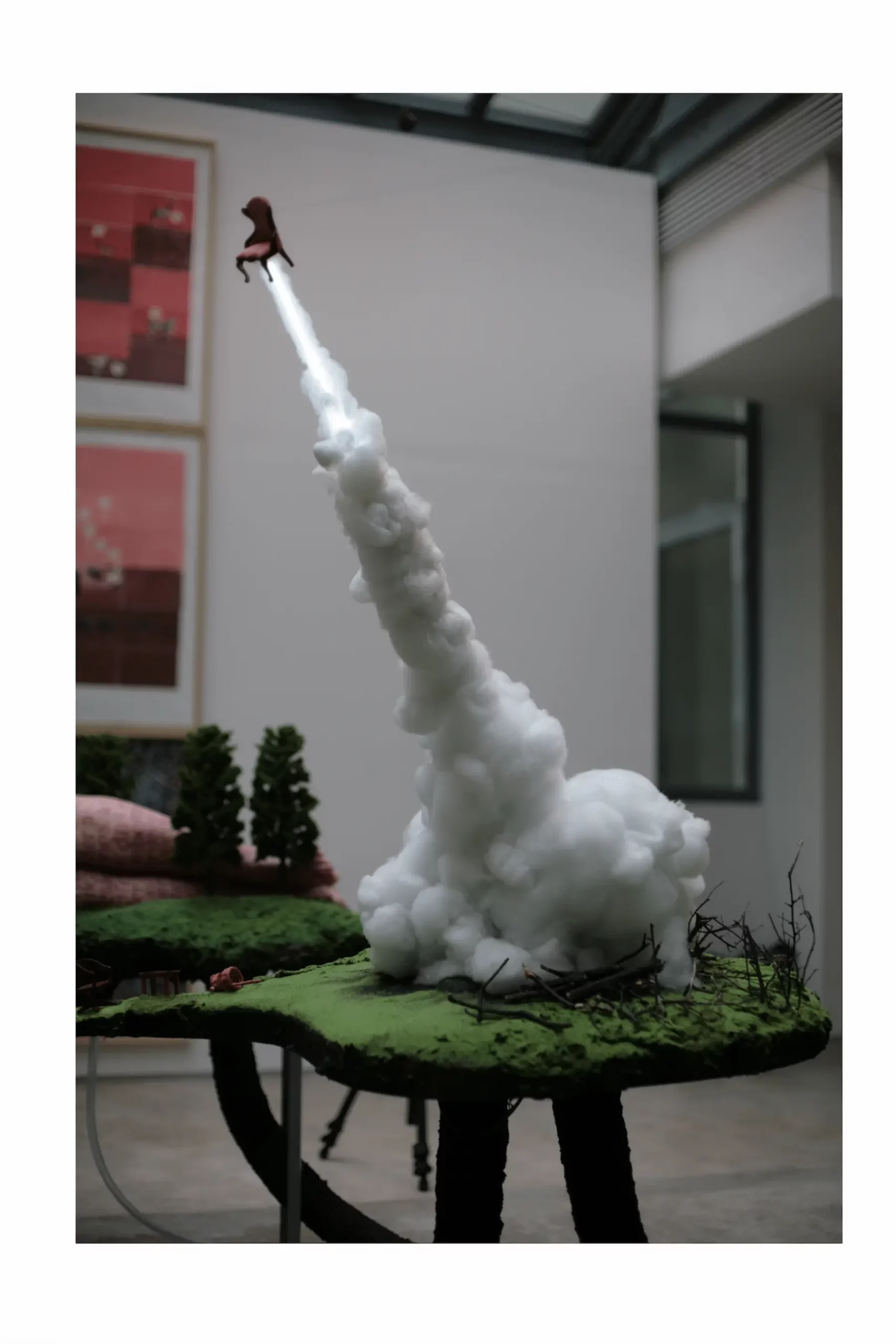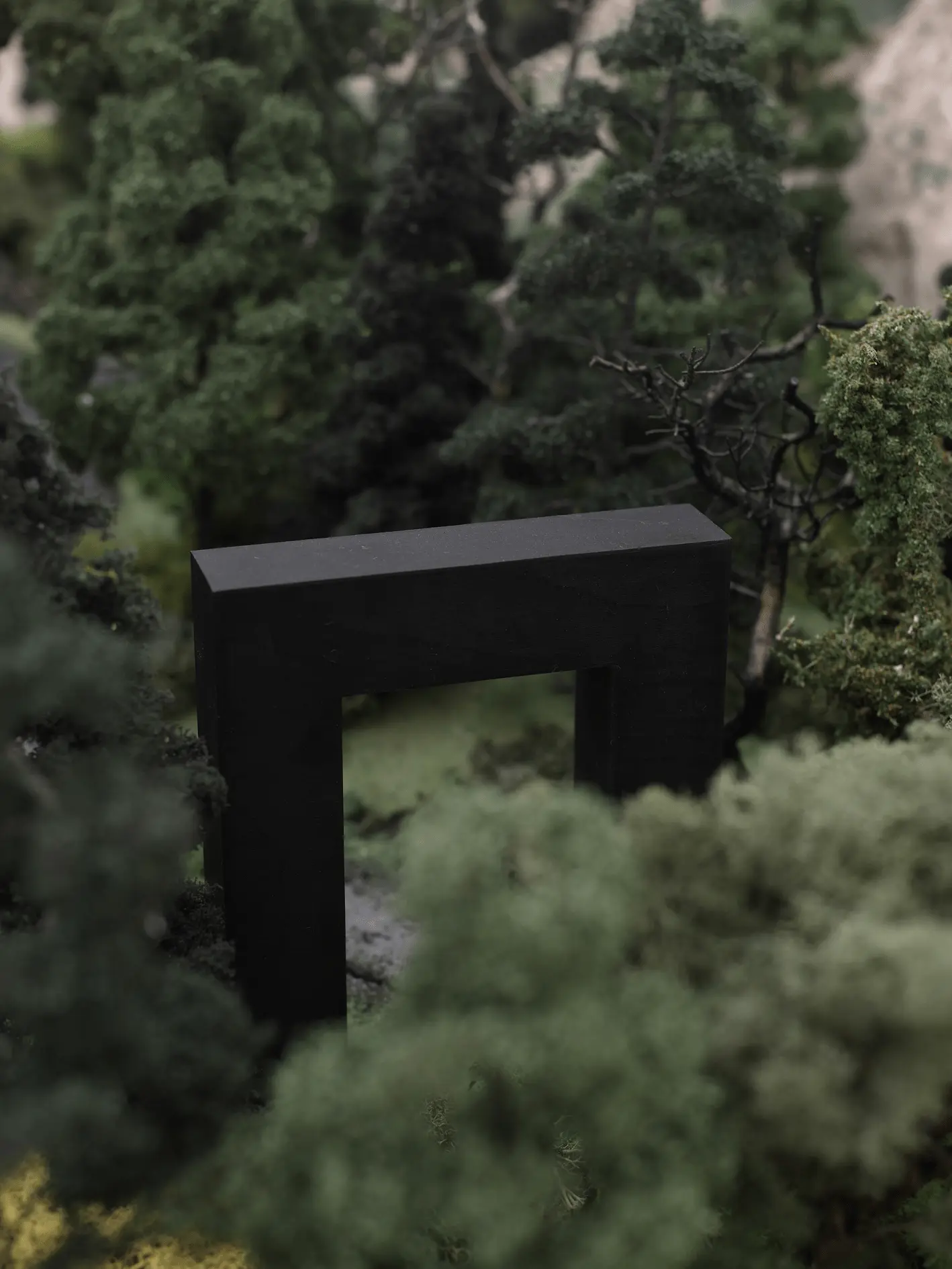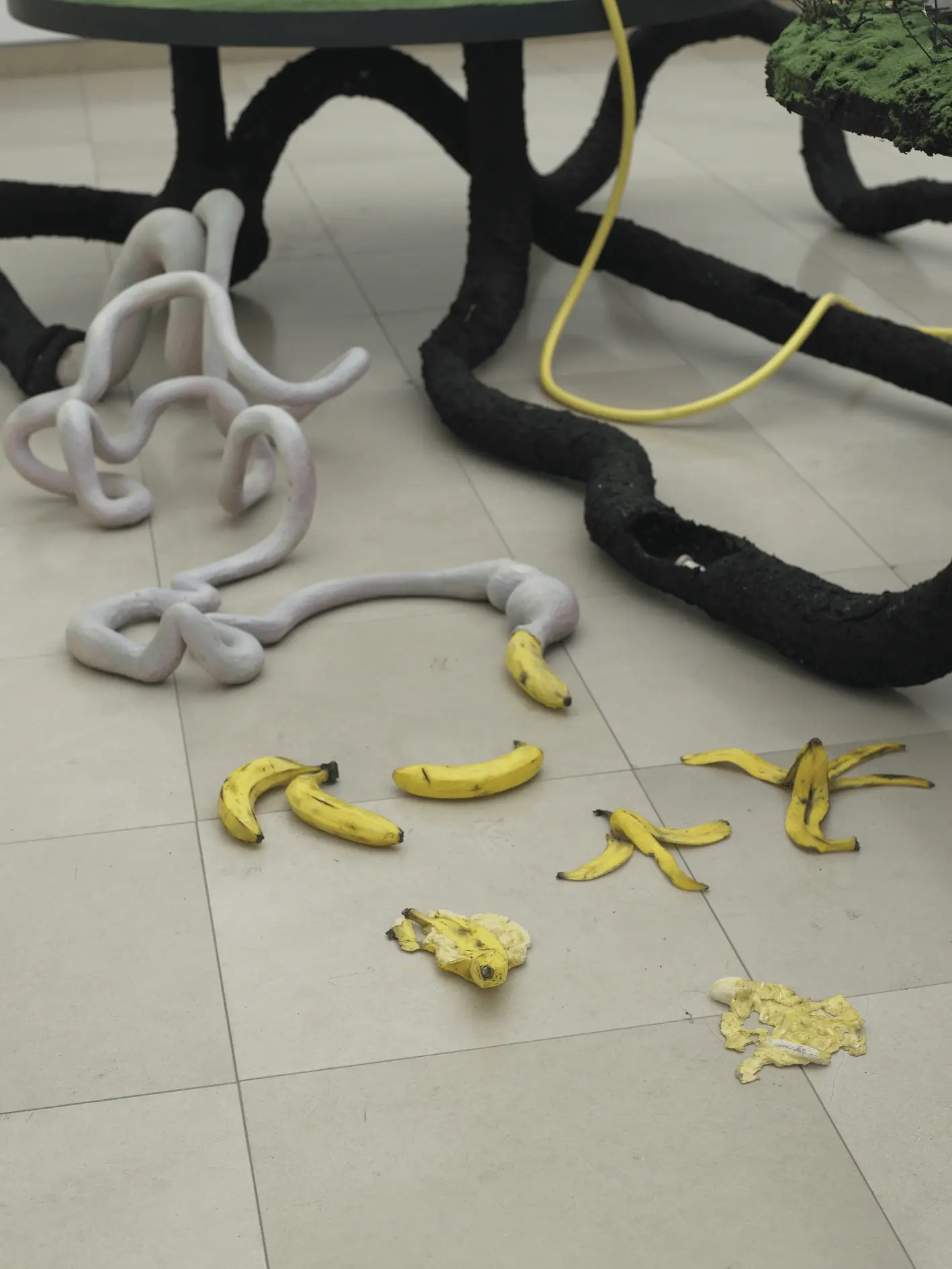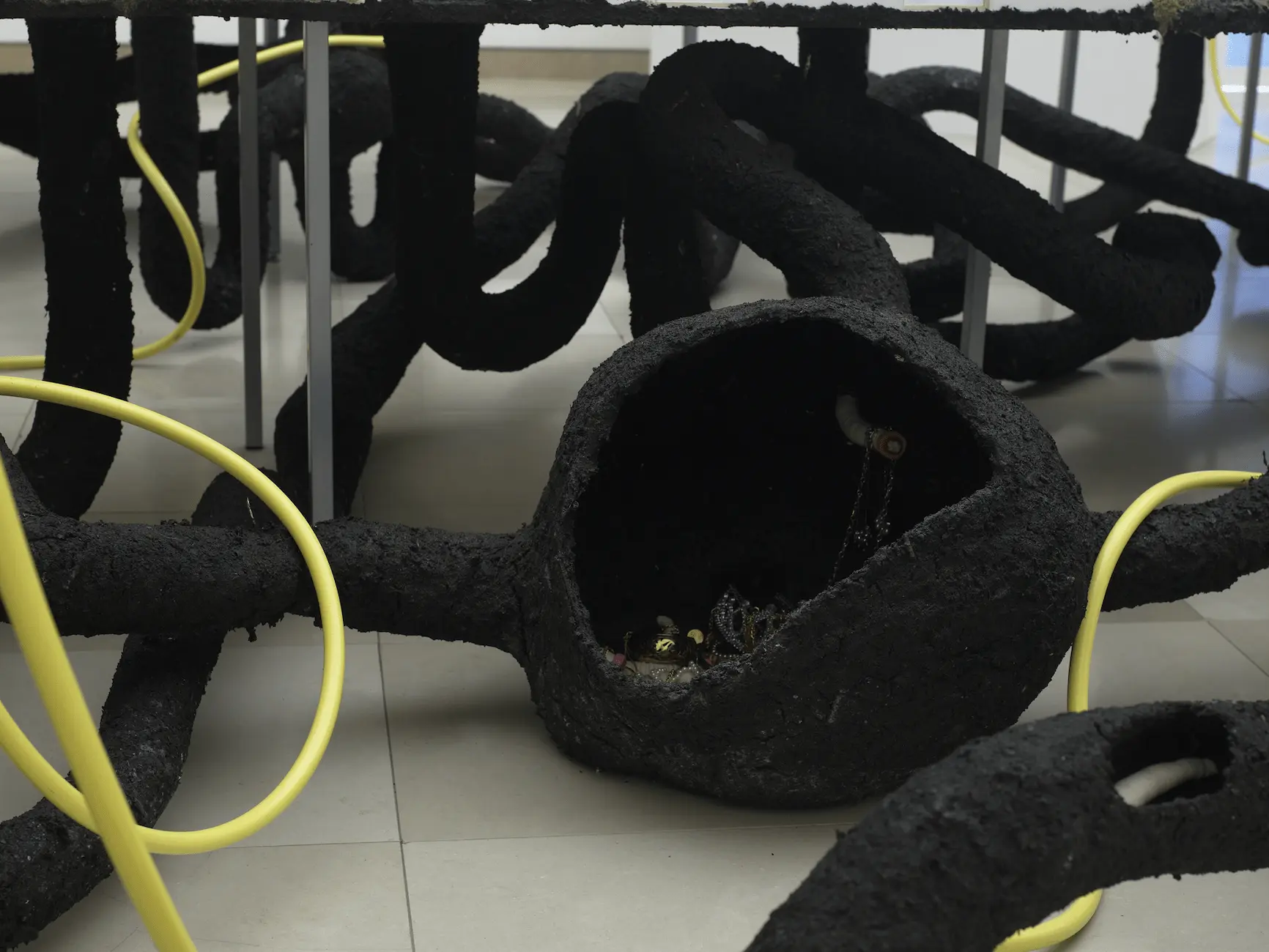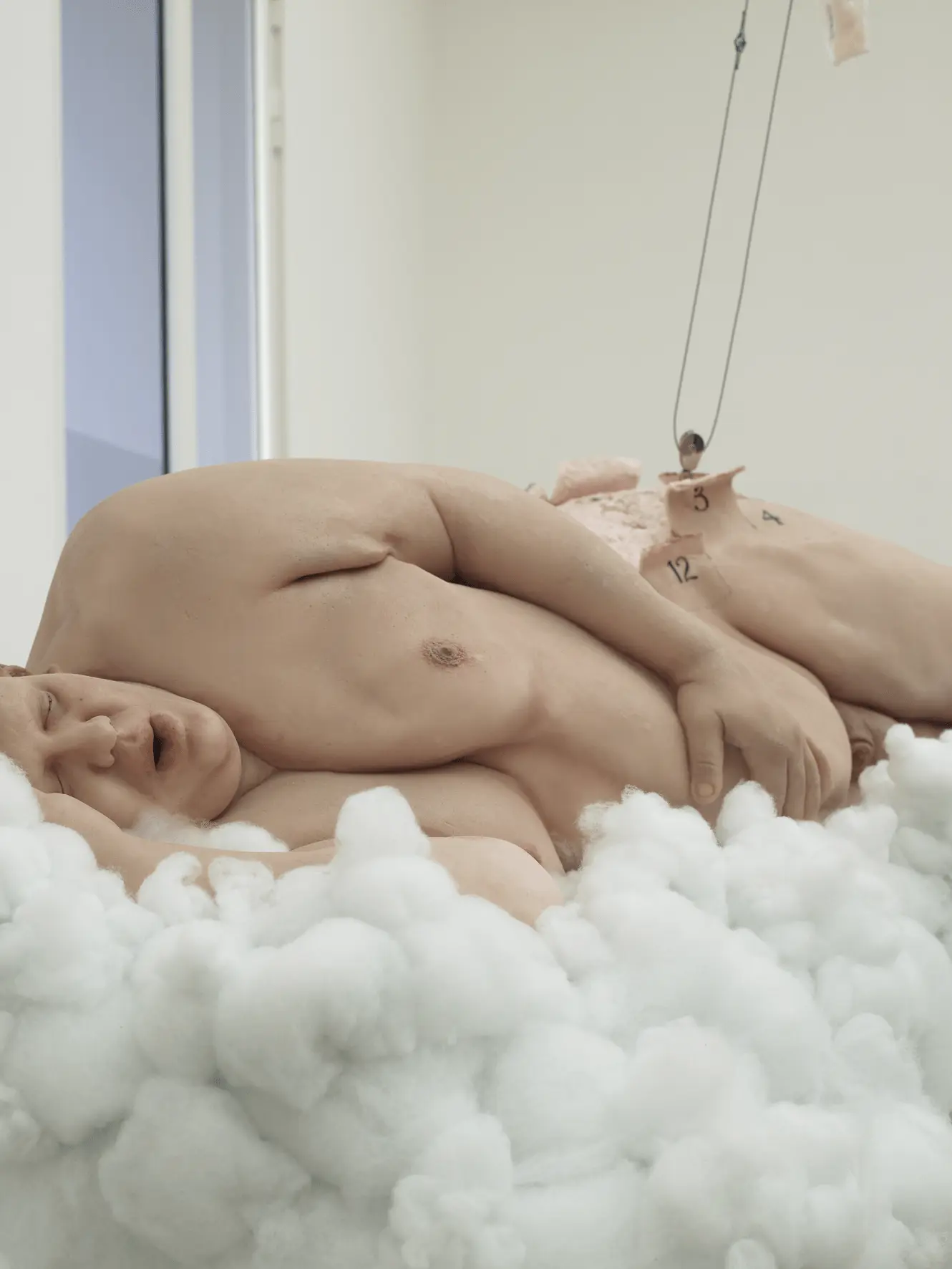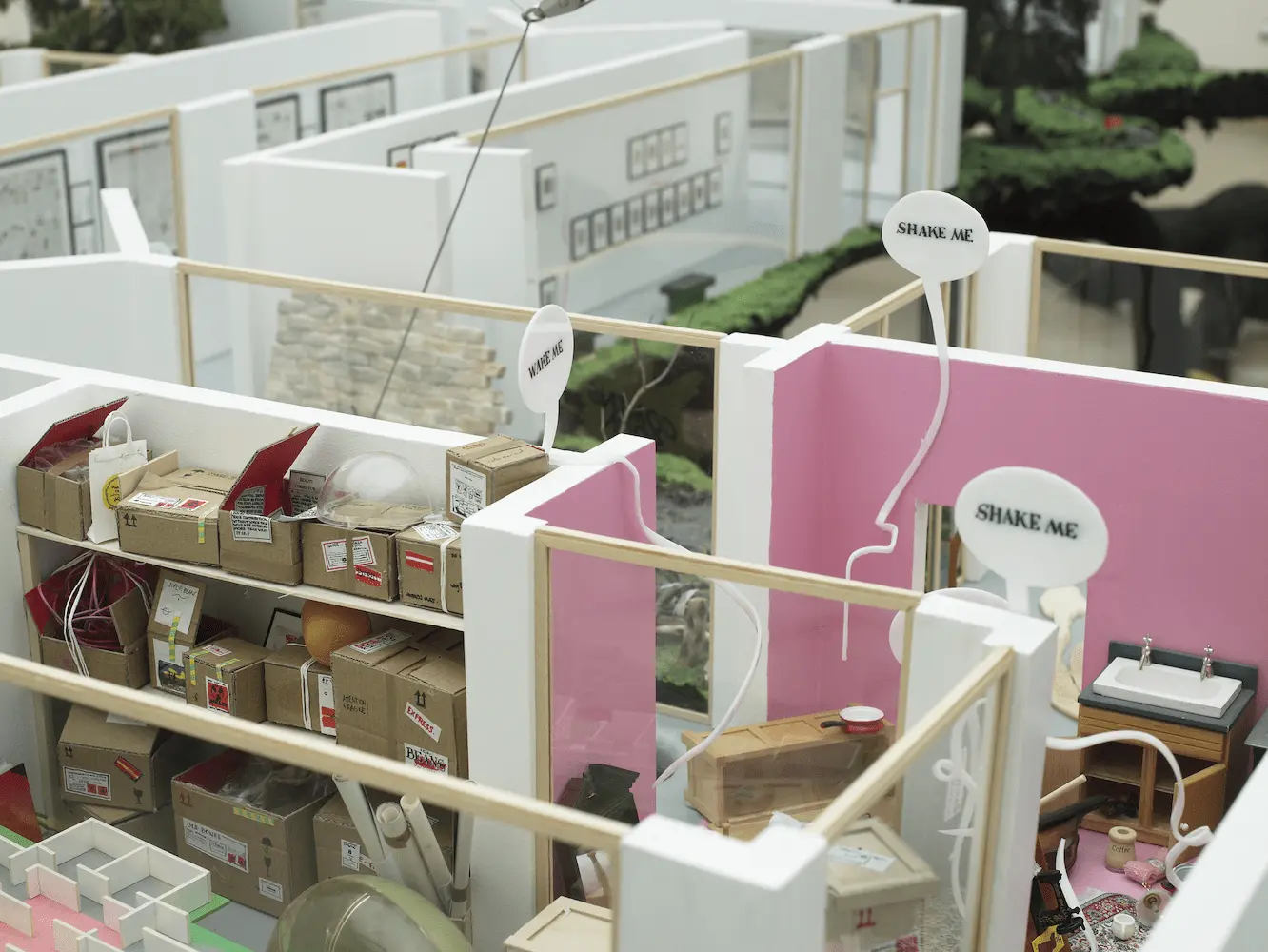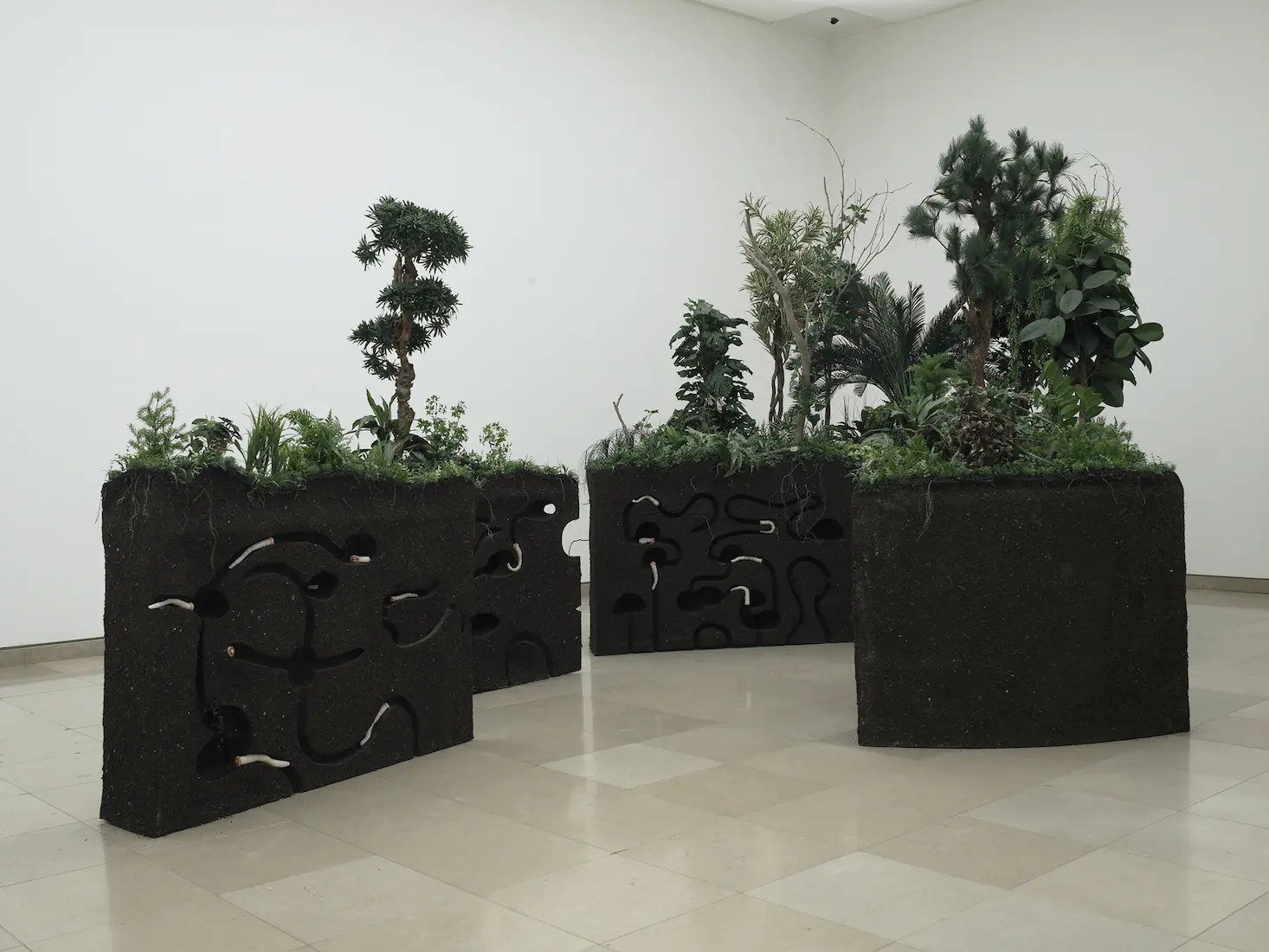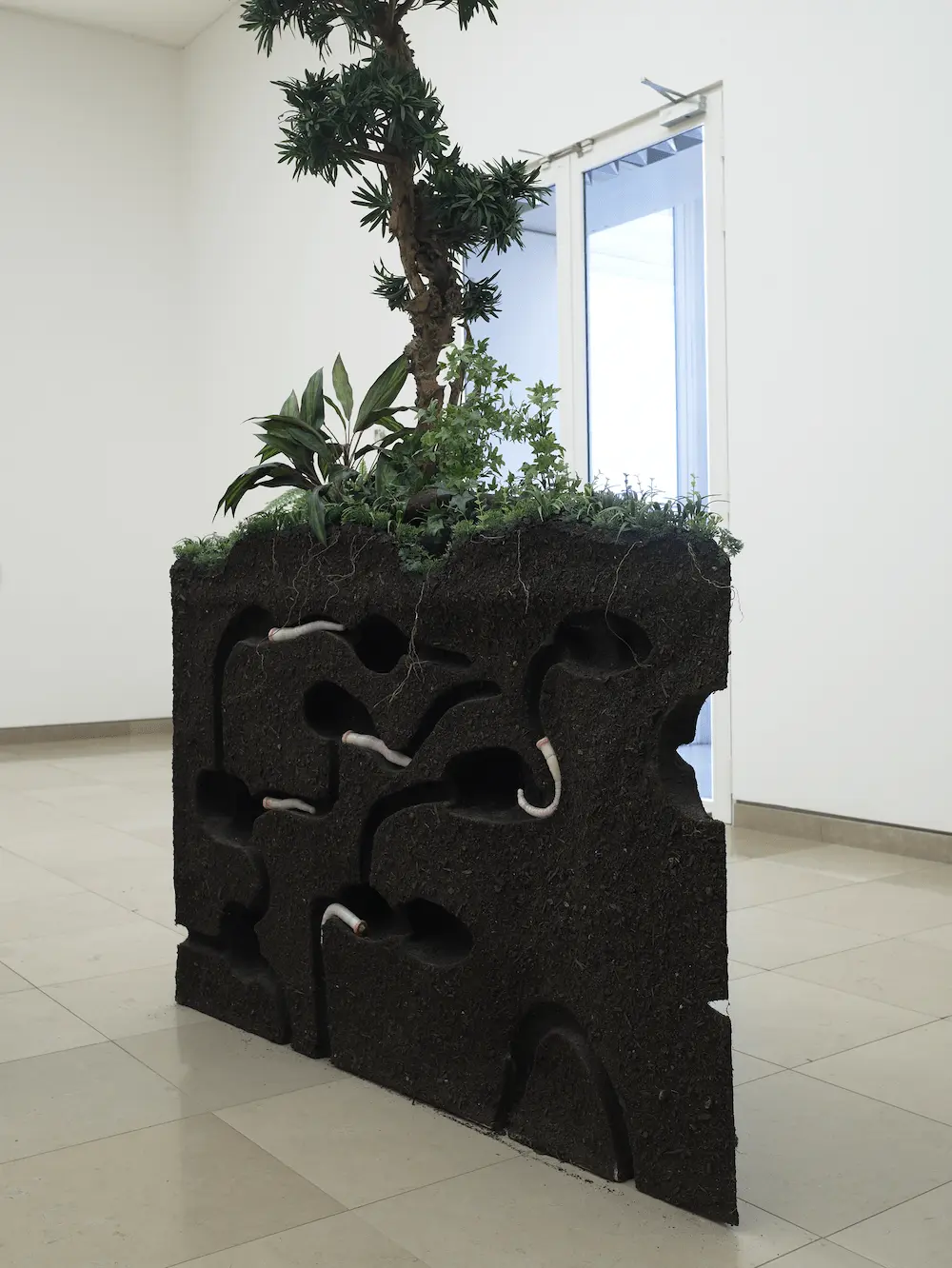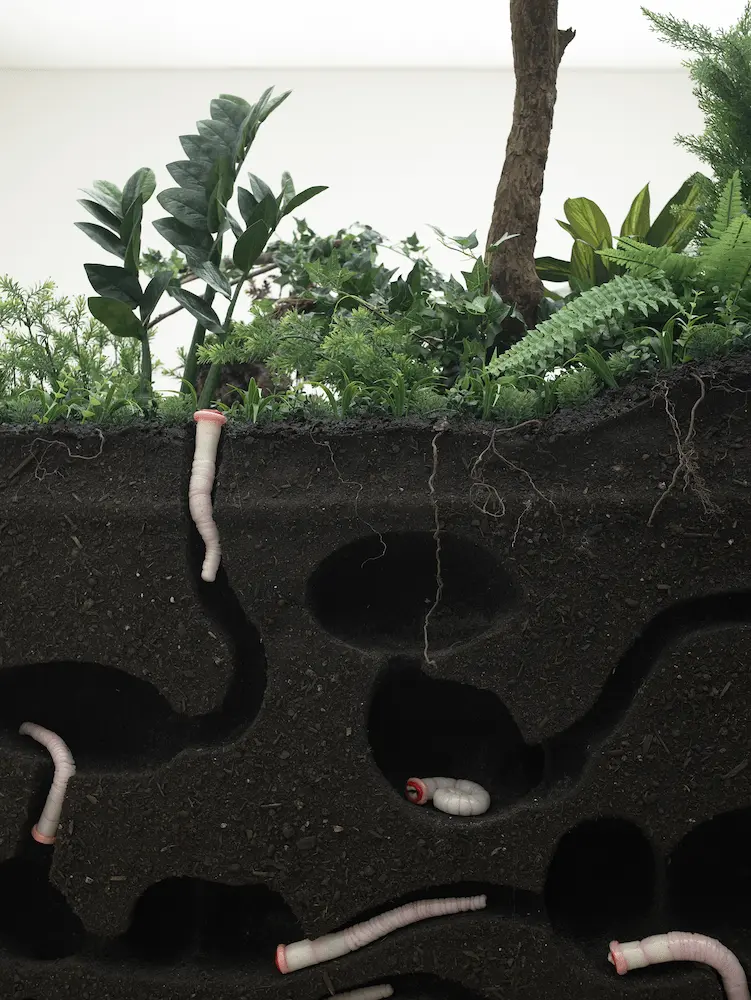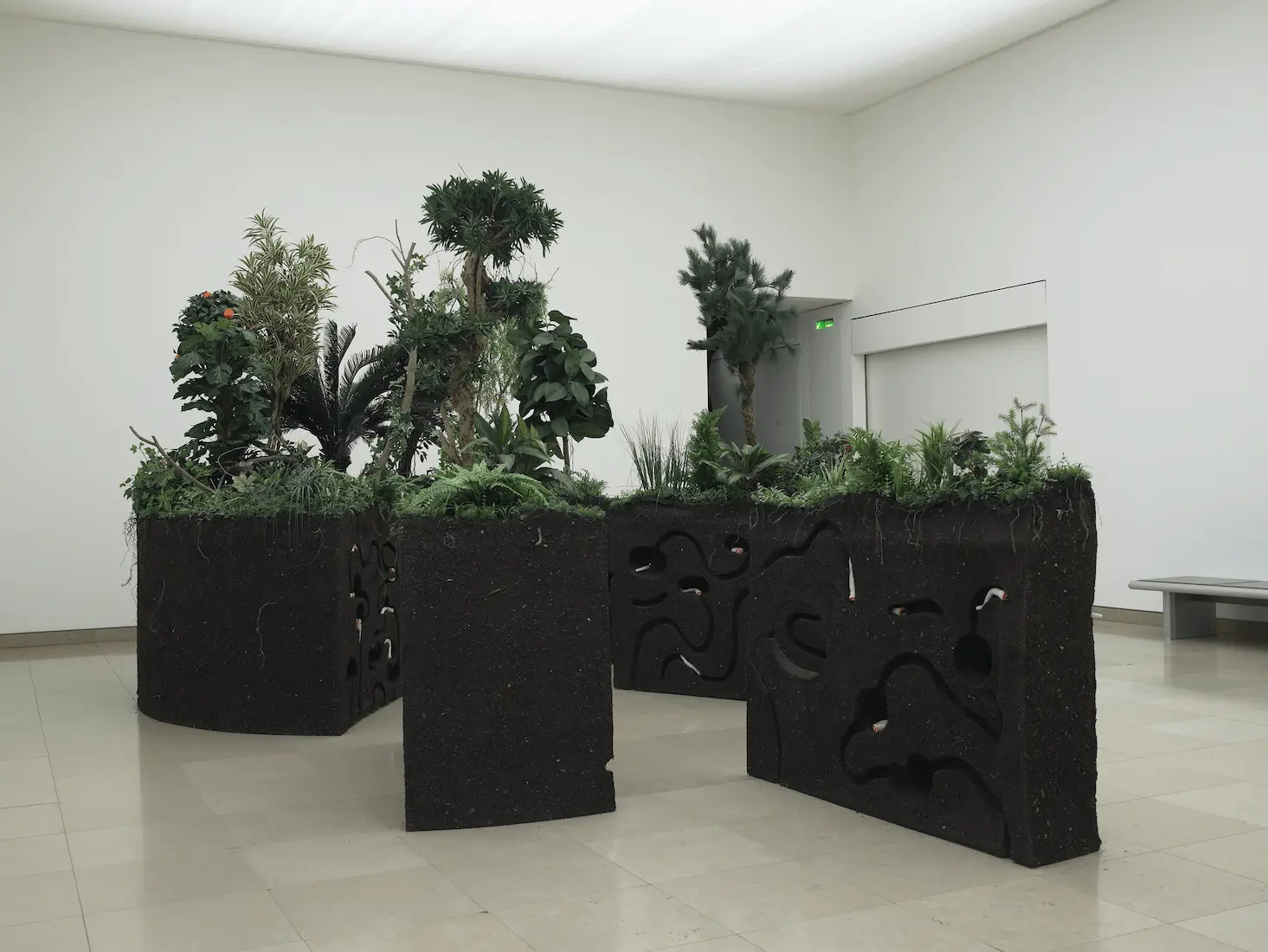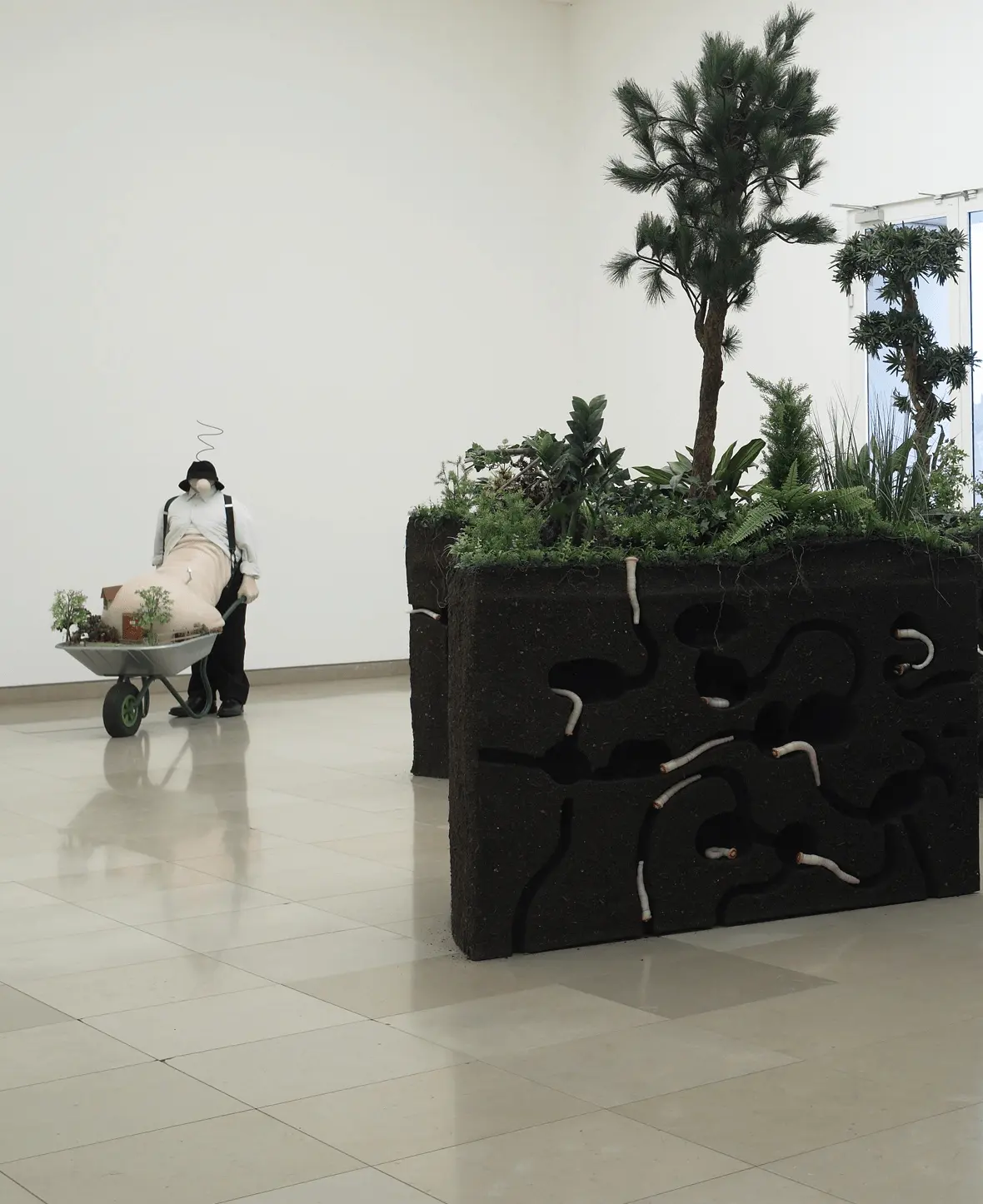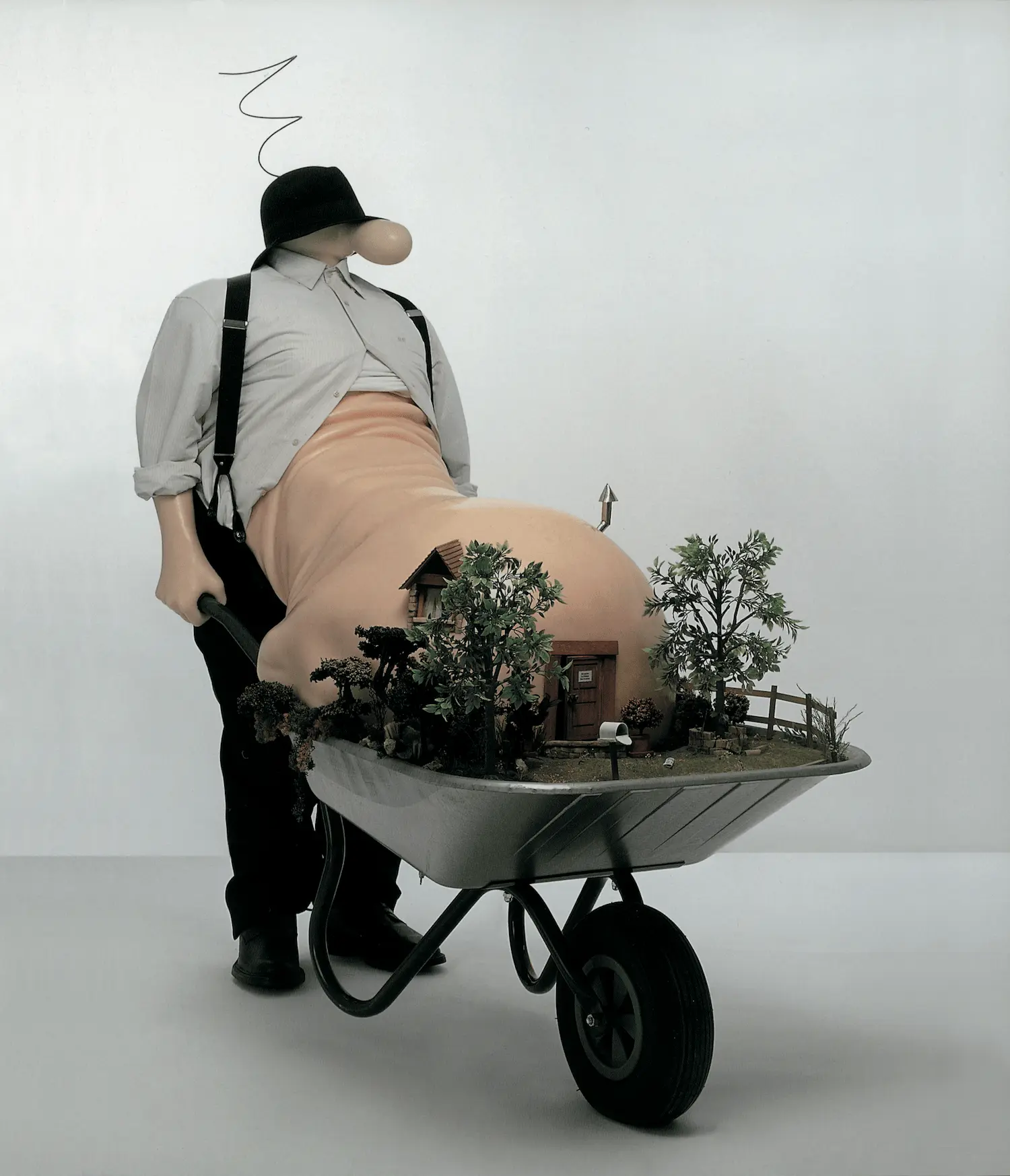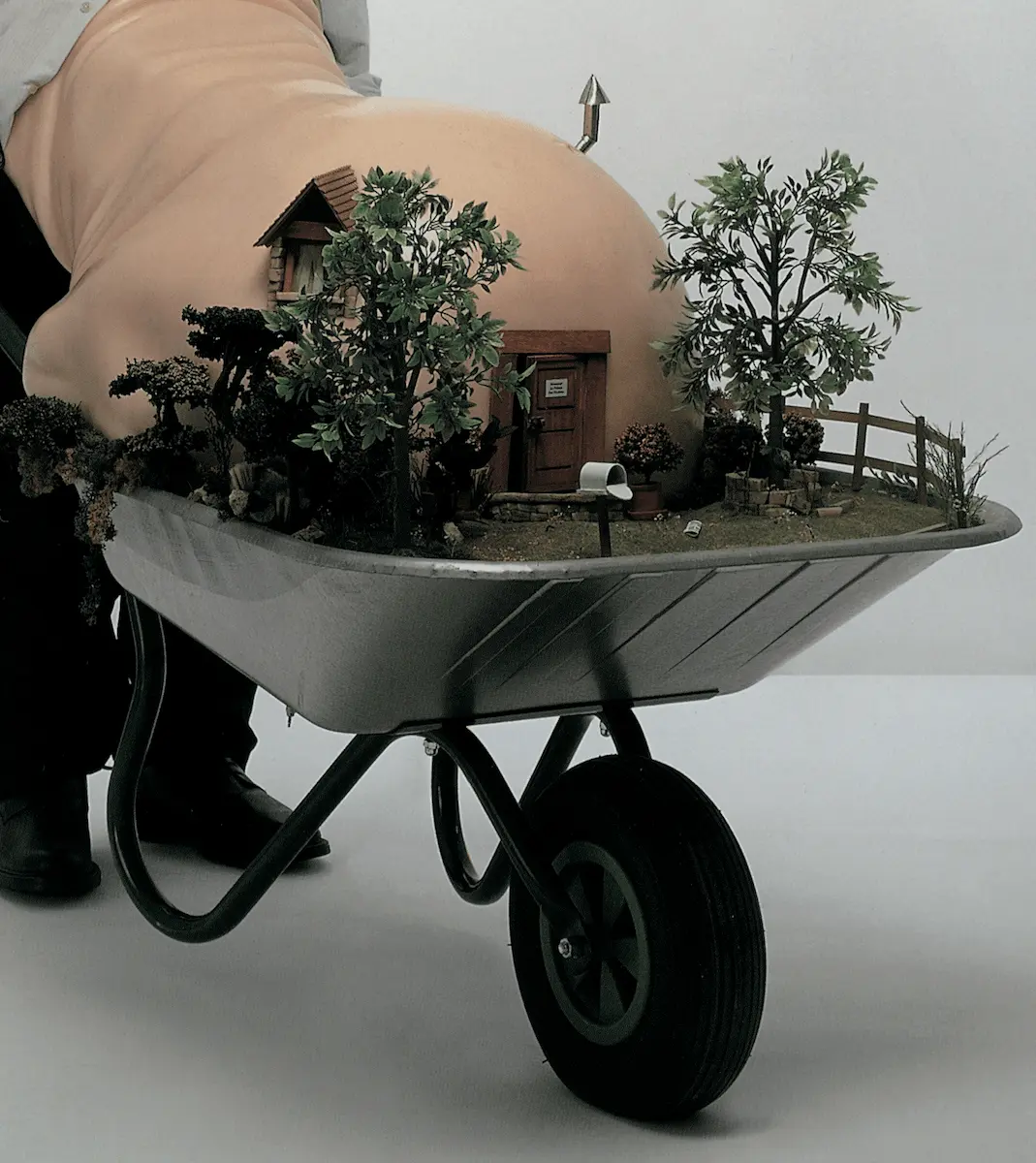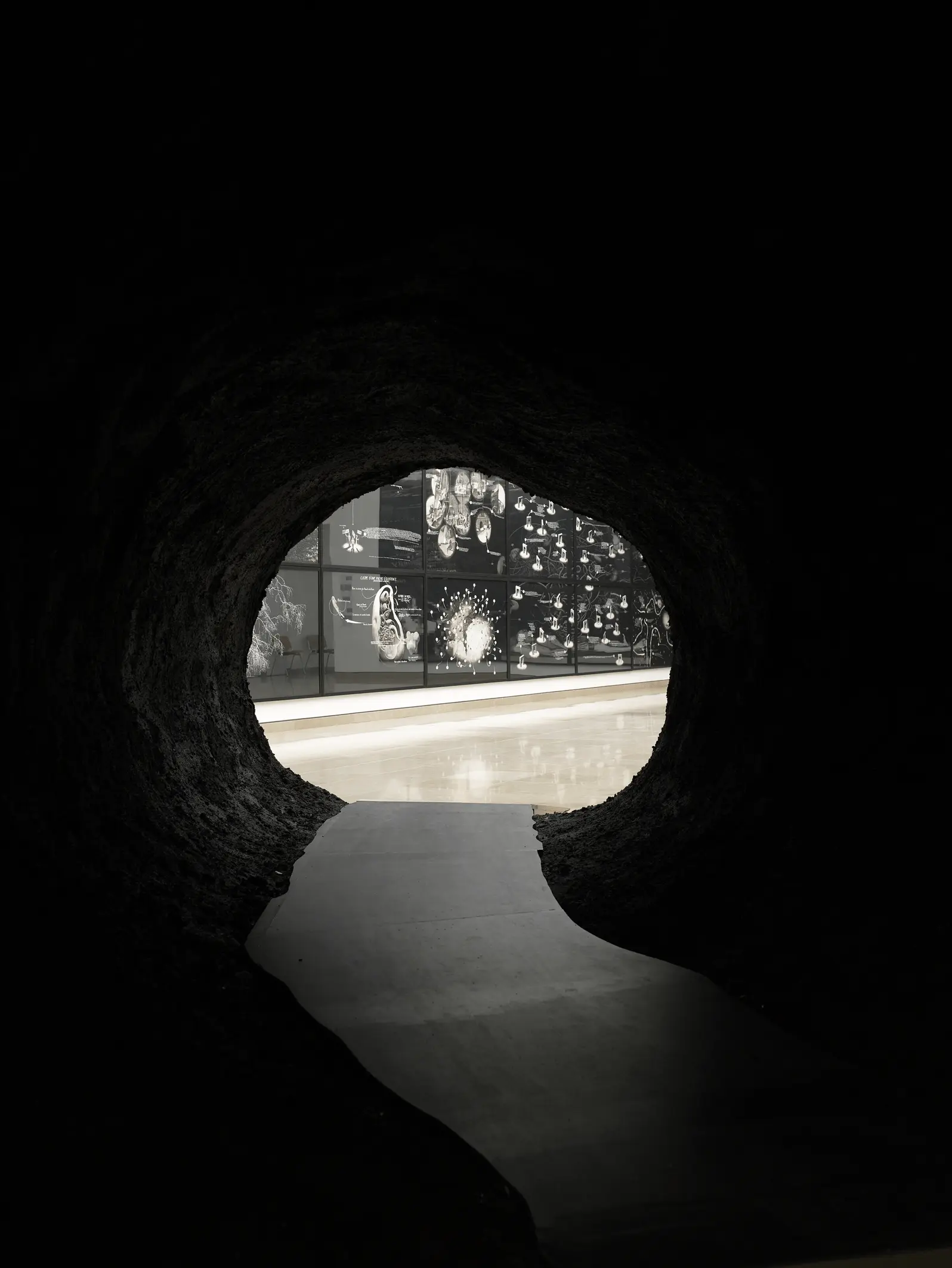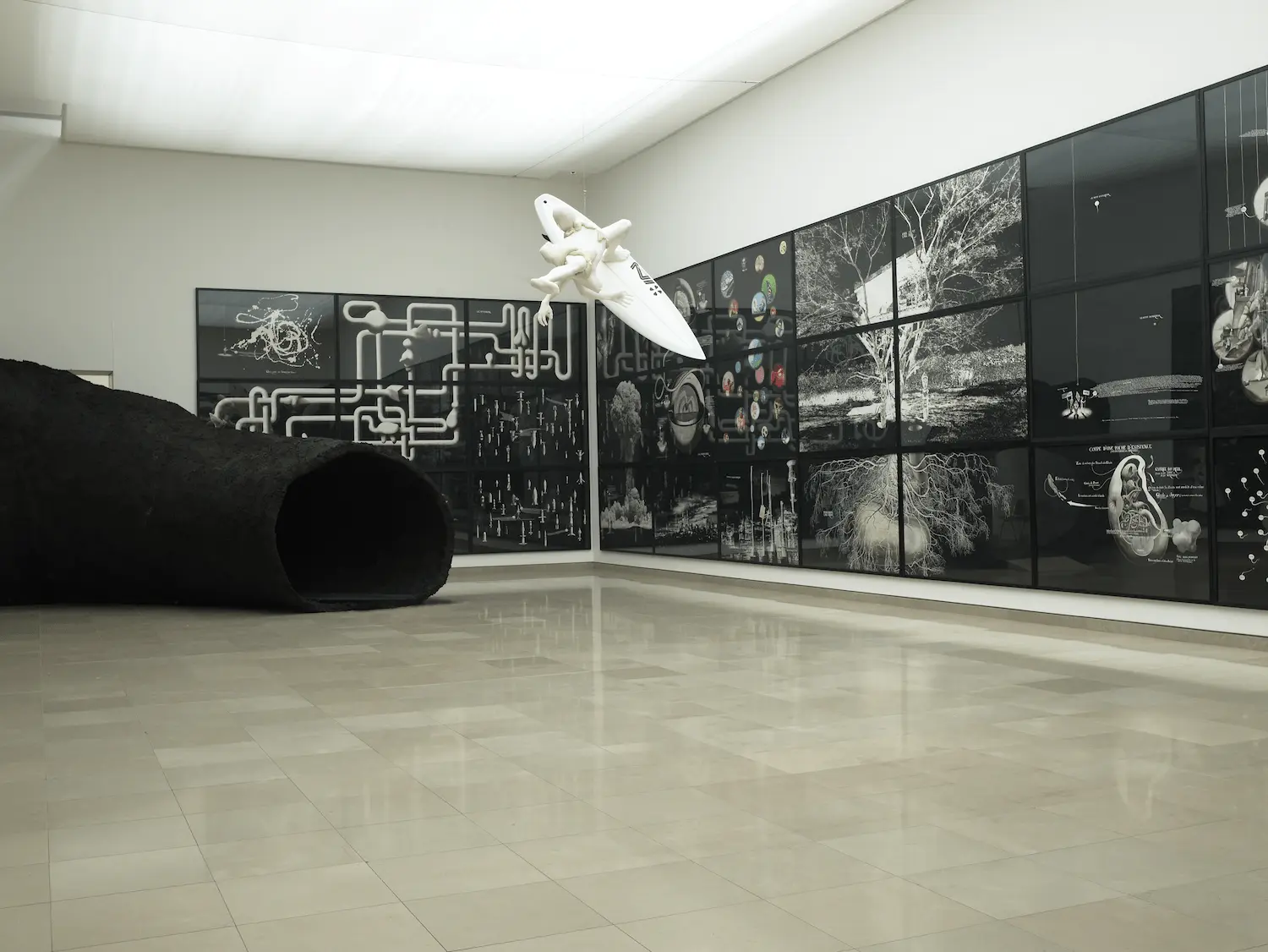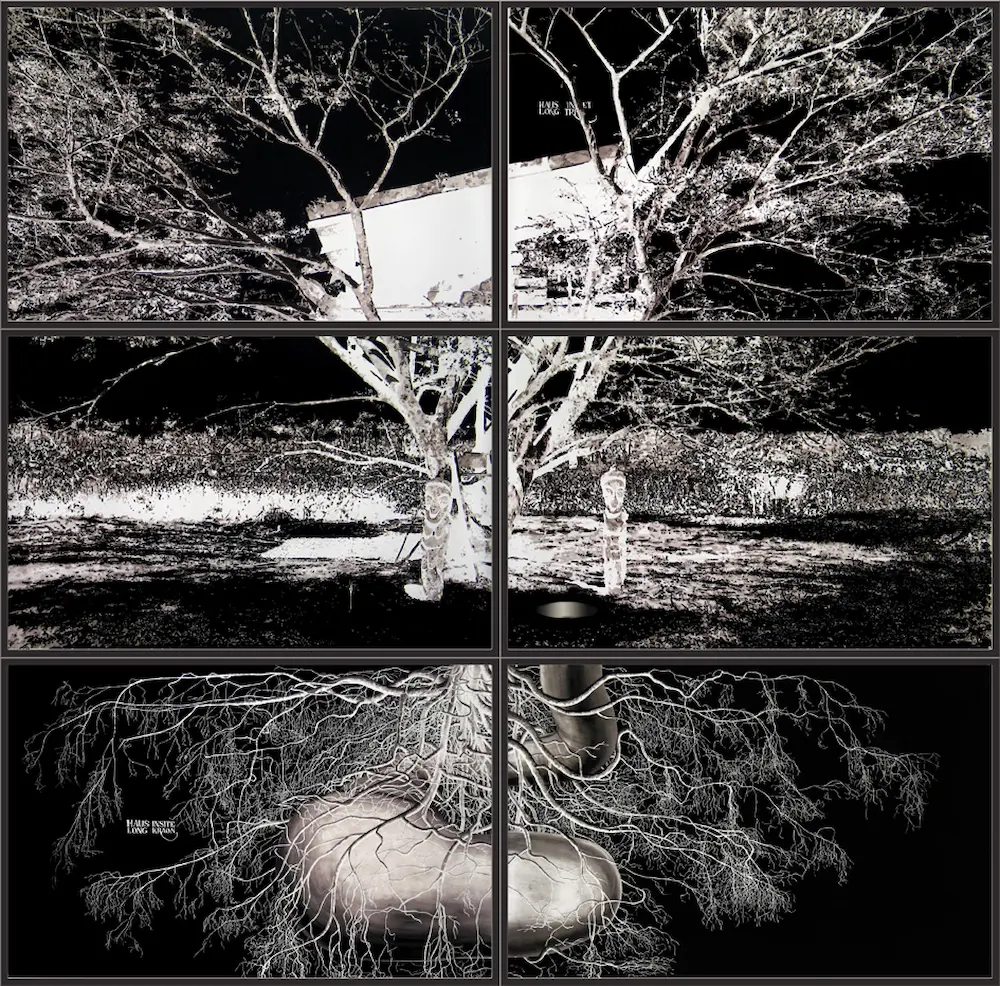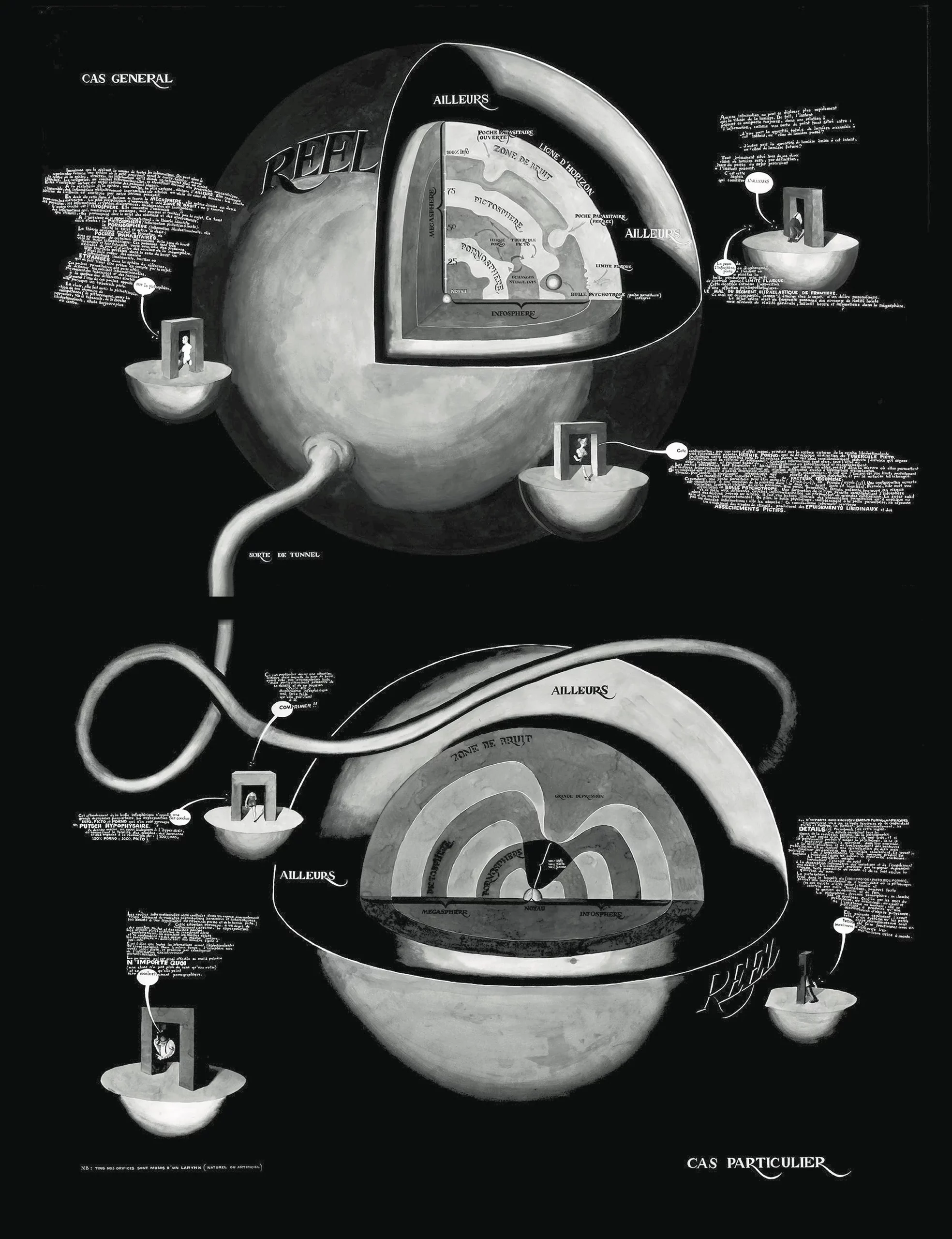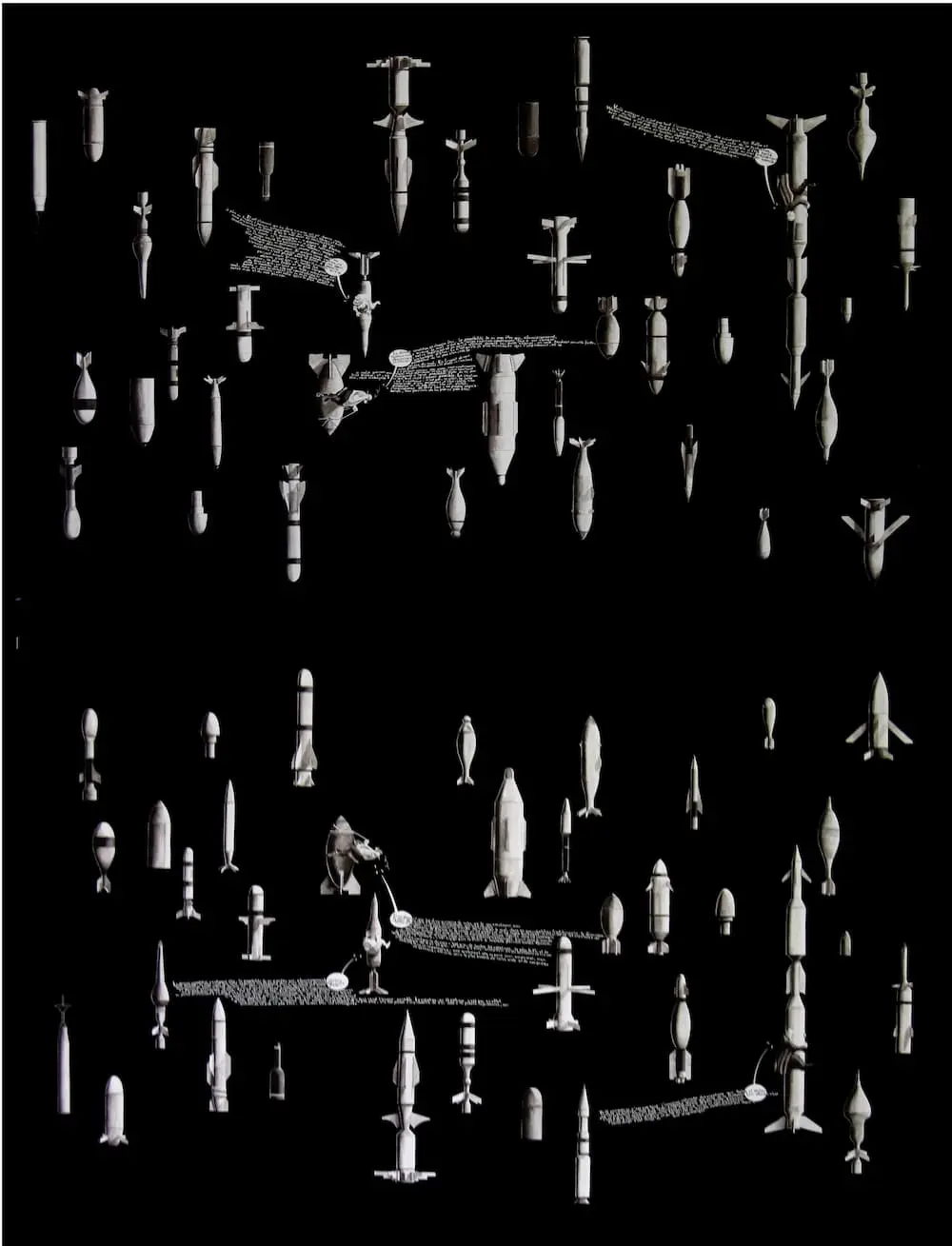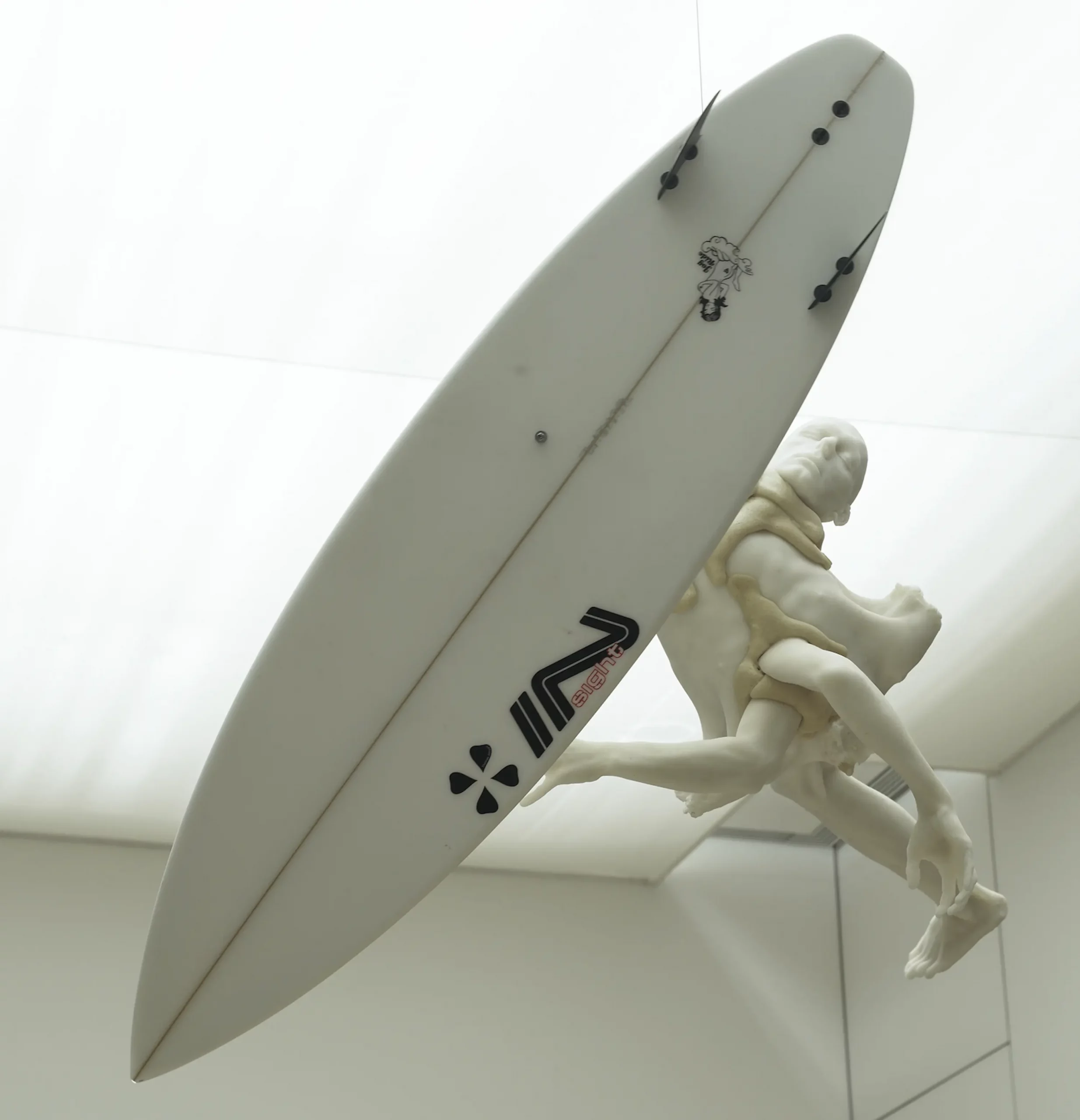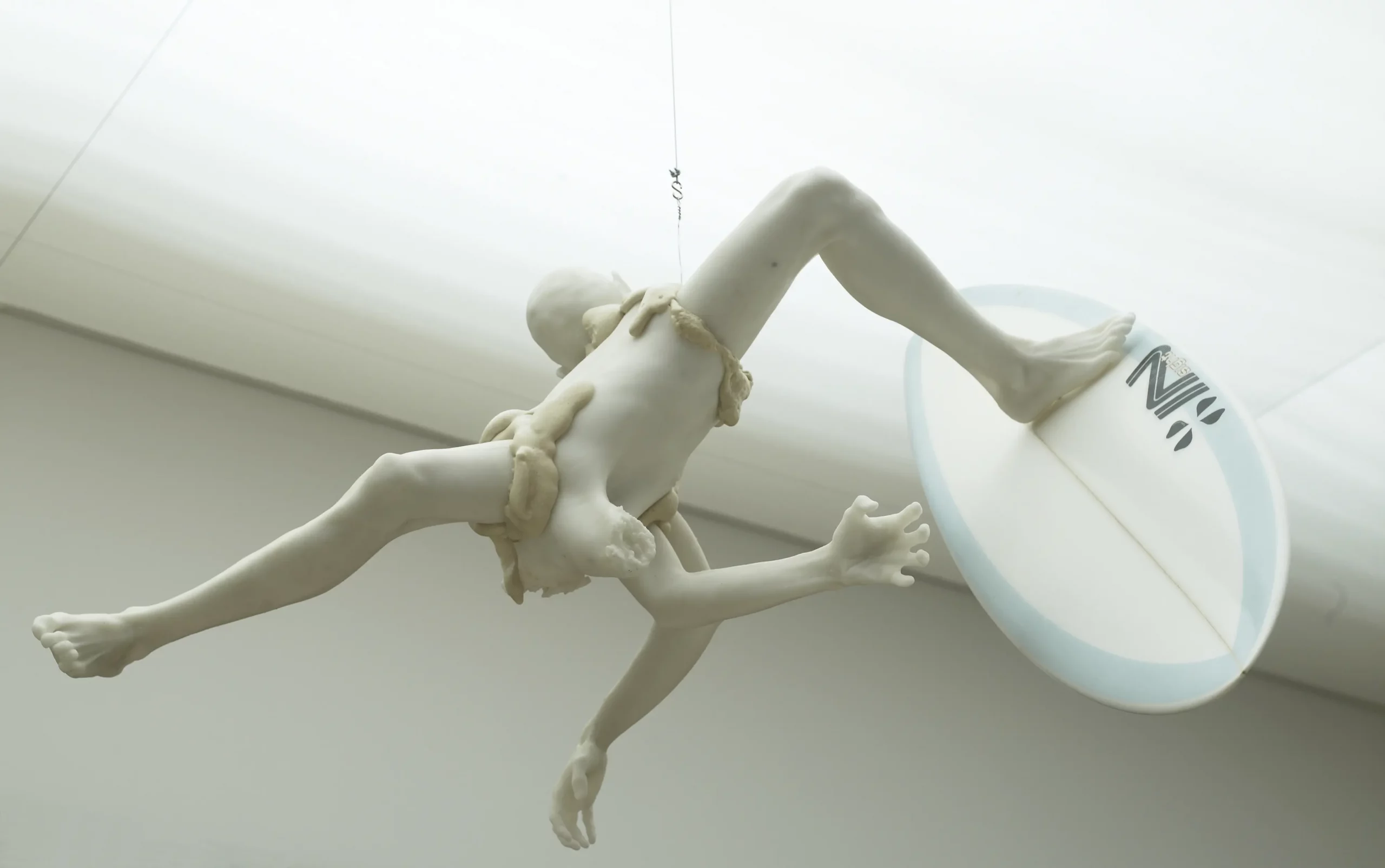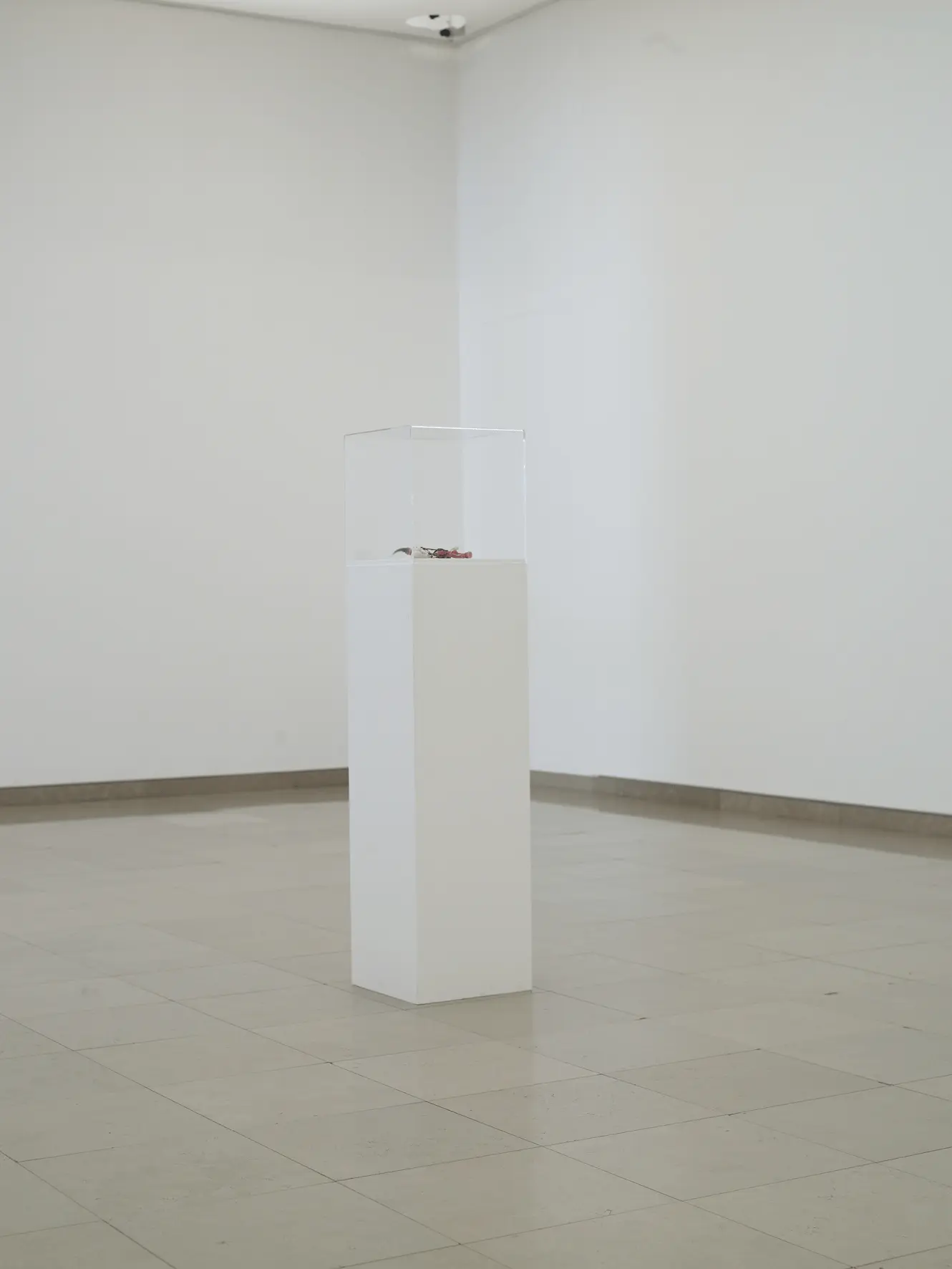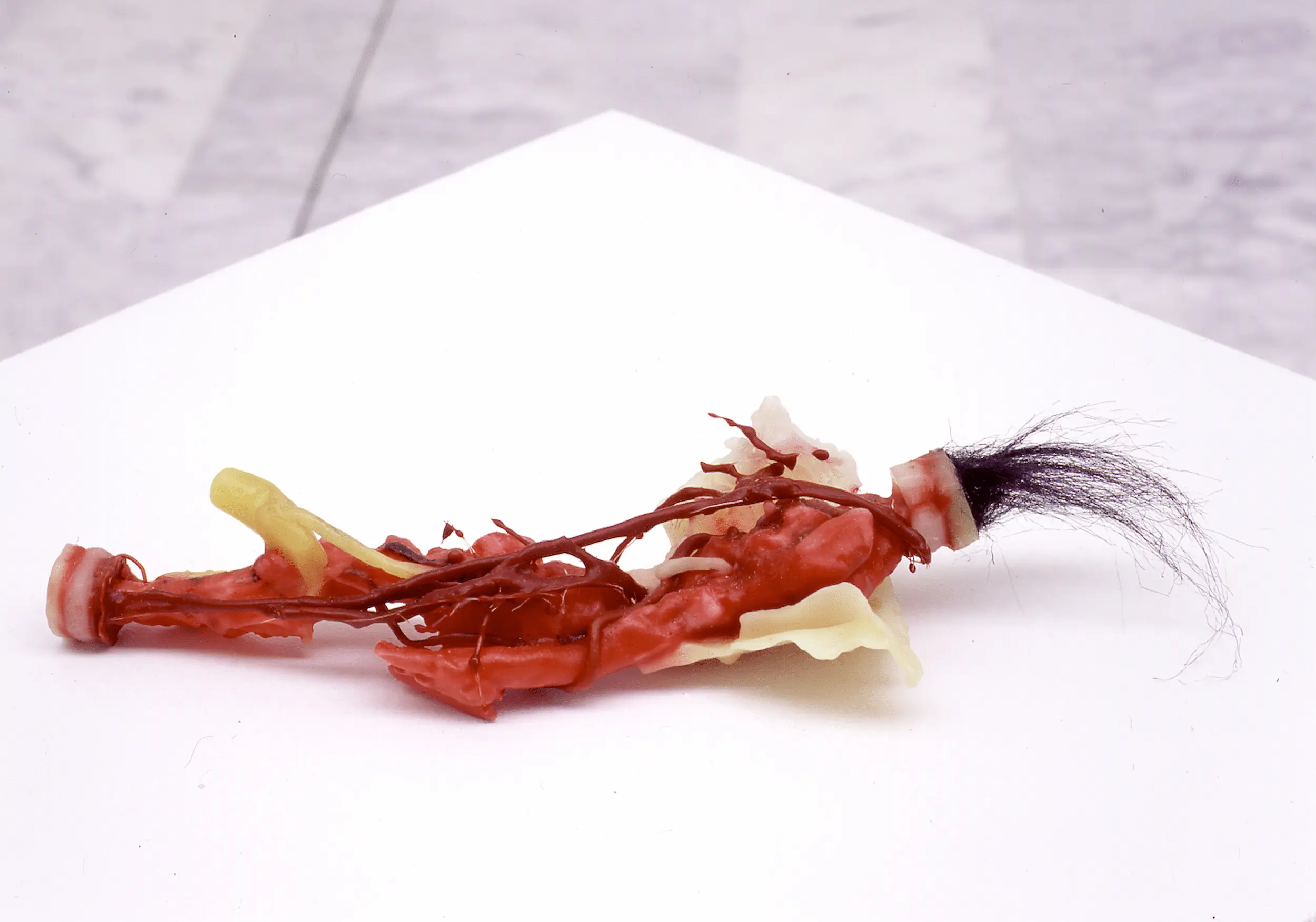“Gilles Barbier” exhibition.
Carré d’Art de Nîmes.
(…) The journey imagined by the artist, based on a hundred or so works, the earliest of which date back to 1993, tends to subvert Norman Foster’s clear, orderly architecture to induce differentiated rhythms in which the movement of the body materializes the movement of thought: braking the reading of dictionary pages and programming drawings, wandering through the galleries of the burrow, exiting into the interstellar darkness of the black drawings, the explosive crossing of the ball that ends the exhibition. Yet the exhibition is not a retrospective. Rather, it is a fresh mix of old and new works. Indeed, Gilles Barbier defines his working method as rumination. In the same way that the catalog is organized around four interviews that examine the work from different angles, all equally relevant, but which can never be said to exhaust the question, the exhibition is the demonstration of approximate truths, but does not seek a central message that sums it all up.
Read more
He prefers instability and slippage to the position of the Artist or Author, who stages a world parallel to reality, autonomous and perfectly asserted. He claims to be an open space swept by different motifs, which materialize in his works: words, brand names, questions, precepts, comic bubbles, reality correctors, a whole logorrhea inseparable from his work. Words come first. Indeed, he says: “I can even say that what is produced (and here I’m talking about my entire output) is basically just an illustration of the text. Or perhaps, more precisely, in a bizarre twist, the text is the illumination. This is how we should understand the frequently-mentioned tenant/owner opposition. Most of the plays assert the plural: the use of the clone is recurrent, multiplying the same character but, from play to play, developing a kind of role-playing: the drunkard, the tenderfoot… but always with the same face, that of the artist. This instability also bears witness to an age in which we can find many more images on the Internet than in any artist’s imagination.
From his long association with science fiction and comics, Gilles Barbier has developed a keen interest in fiction and an ability to imagine spaces and organisms: pockets of existence, ectoplasm… that embody the workings of abstract principles, developing a conceptually sustained yet highly figurative way of thinking. The work is nourished by a multitude of concepts in physics, artificial intelligence and information theory. He is interested in space adventure, anatomy, the atomic bomb explosion in Hiroshima or myth (the Lochness Monster). In a way, it appears as a hypertrophy of reasoning and intelligence, materialized by the journey through innumerable galleries, passages and themes that are constantly repeated. There is no evolution in the work, and no work is a stranger to the next. At any moment, the story can begin anew, often from an element of the work newly chosen to be the beginning. (…)
Extract from the presentation text by Françoise Cohen, Director of Carré d’Art de Nîmes.
“Gilles Barbier” exhibition at Carré d’Art in Nîmes. “ The Tender Foot ”.
Gilles Barbier” exhibition at Carré d’Art in Nîmes. “ The Tender Foot ”.
“Gilles Barbier” exhibition at Carré d’Art in Nîmes. “ The Tender Foot ”.
Gilles Barbier” exhibition at Carré d’Art in Nîmes. “ The Tender Foot ”.
“Gilles Barbier” exhibition at Carré d’Art in Nîmes. “24 Posters” (Detail).
“Gilles Barbier” exhibition at Carré d’Art in Nîmes. “24 Posters” (Detail).
“Gilles Barbier” exhibition at Carré d’Art in Nîmes. “24 Posters” (Detail).
“Gilles Barbier” exhibition at Carré d’Art in Nîmes. “24 Posters” (Detail).
“Gilles Barbier” exhibition at Carré d’Art in Nîmes. “24 Posters” (Detail).
“Gilles Barbier” exhibition at Carré d’Art in Nîmes. “24 Posters” (Detail).
“Gilles Barbier” exhibition at Carré d’Art in Nîmes. “24 Posters” (Detail).
“Gilles Barbier” exhibition at Carré d’Art in Nîmes. “24 Posters” (Detail).
“Gilles Barbier” exhibition at Carré d’Art in Nîmes. “24 Posters” (Detail).
“Gilles Barbier” exhibition at Carré d’Art in Nîmes. “24 Posters” (Detail).
“Gilles Barbier” exhibition at Carré d’Art, Nîmes. “80 Projects”. In the center, “The Twins”.
“Gilles Barbier” exhibition at Carré d’Art, Nîmes. “80 Projects”. In the center, “The Twins”.
“Gilles Barbier” exhibition at Carré d’Art in Nîmes. “80 Projects”. In the center, “ The Twins ”.
Gilles Barbier” exhibition at Carré d’Art in Nîmes. “80 Projects”. In the center, “ The Twins ”.
“Gilles Barbier” exhibition at Carré d’Art, Nîmes. “ A wall ”.
Gilles Barbier” exhibition at Carré d’Art, Nîmes. “ A wall ”.
“Gilles Barbier” exhibition at Carré d’Art, Nîmes. “80 Projects: Damo Suzuki”.
“Gilles Barbier” exhibition at Carré d’Art, Nîmes. “80 Projects: Damo Suzuki”.
“Gilles Barbier” exhibition at Carré d’Art, Nîmes. “ Storage structures ”.
Gilles Barbier” exhibition at Carré d’Art, Nîmes. “ Storage structures ”.
“Gilles Barbier” exhibition at Carré d’Art, Nîmes. “Structures of growth”.
Gilles Barbier” exhibition at Carré d’Art, Nîmes. “Structures of growth”.
“Gilles Barbier” exhibition at Carré d’Art, Nîmes. “80 Projects: Islands”.
Gilles Barbier” exhibition at Carré d’Art, Nîmes. “80 Projects: Islands”.
“Gilles Barbier” exhibition at Carré d’Art, Nîmes. “80 Projects: The Cockpit”.
Gilles Barbier” exhibition at Carré d’Art, Nîmes. “80 Projects: The Cockpit”.
“Gilles Barbier” exhibition at Carré d’Art, Nîmes. “80 Projects: Houses in trees”.
Gilles Barbier” exhibition at Carré d’Art, Nîmes. “80 Projects: Houses in trees”.
“Gilles Barbier” exhibition at Carré d’Art, Nîmes. “80 Projets: Who’s hiding in André Rieu’s fold?”.
Gilles Barbier” exhibition at Carré d’Art, Nîmes. “80 Projets: Who’s hiding in André Rieu’s fold?”.
“Gilles Barbier” exhibition at Carré d’Art, Nîmes. “80 Projects: Today I do this, tonight I break it, tomorrow I start something else”.
Gilles Barbier” exhibition at Carré d’Art, Nîmes. “80 Projects: Today I do this, tonight I break it, tomorrow I start something else”.
“Gilles Barbier” exhibition at Carré d’Art in Nîmes. “Old Woman with Tattoos.
“Gilles Barbier” exhibition at Carré d’Art in Nîmes. “Old Woman with Tattoos.
“Gilles Barbier” exhibition at Carré d’Art in Nîmes. “Old Woman with Tattoos.
“Gilles Barbier” exhibition at Carré d’Art in Nîmes. “Old Woman with Tattoos.
“Gilles Barbier” exhibition at Carré d’Art in Nîmes. “Old Woman with Tattoos. (Detail).
“Gilles Barbier” exhibition at Carré d’Art in Nîmes. “Old Woman with Tattoos. (Detail).
“Gilles Barbier” exhibition at Carré d’Art, Nîmes. “Le Larousse (copies)”. Center: “Old Woman with Tattoos”.
“Gilles Barbier” exhibition at Carré d’Art, Nîmes. “Le Larousse (copies)”. Center: “Old Woman with Tattoos”.
“Gilles Barbier” exhibition at Carré d’Art, Nîmes. “From DIRECTION to ÉLAGUER” and its six Errata.
“Gilles Barbier” exhibition at Carré d’Art, Nîmes. “From DIRECTION to ÉLAGUER” and its six Errata.
“Gilles Barbier” exhibition at Carré d’Art, Nîmes. “From DIRECTION to ÉLAGUER”. Detail.
“Gilles Barbier” exhibition at Carré d’Art, Nîmes. “From DIRECTION to ÉLAGUER”. Detail.
“Gilles Barbier” exhibition at Carré d’Art, Nîmes. “From DIRECTION to ÉLAGUER”. Detail.
“Gilles Barbier” exhibition at Carré d’Art, Nîmes. “From DIRECTION to ÉLAGUER”. Detail.
“Gilles Barbier” exhibition at Carré d’Art, Nîmes. “From DIRECTION to ÉLAGUER”. Errata.
“Gilles Barbier” exhibition at Carré d’Art, Nîmes. “From DIRECTION to ÉLAGUER”. Errata.
“Gilles Barbier” exhibition at Carré d’Art, Nîmes. “From DIRECTION to ÉLAGUER”. Errata.
“Gilles Barbier” exhibition at Carré d’Art, Nîmes. “From DIRECTION to ÉLAGUER”. Errata.
“Gilles Barbier” exhibition at Carré d’Art, Nîmes. “From DIRECTION to ÉLAGUER”. Errata.
“Gilles Barbier” exhibition at Carré d’Art, Nîmes. “From DIRECTION to ÉLAGUER”. Errata.
“Gilles Barbier” exhibition at Carré d’Art, Nîmes. The mega model room.
Gilles Barbier” exhibition at Carré d’Art, Nîmes. The mega model room.
“Gilles Barbier” exhibition at Carré d’Art, Nîmes. The mega model room.
“Gilles Barbier” exhibition at Carré d’Art, Nîmes. The mega model room.
“Gilles Barbier” exhibition at Carré d’Art, Nîmes. Mega model room. Detail : The Toilets.
“Gilles Barbier” exhibition at Carré d’Art, Nîmes. Mega model room. Detail : The Toilets.
“Gilles Barbier” exhibition at Carré d’Art, Nîmes. Mega model room. Detail : Troglodytum Casein.
Gilles Barbier” exhibition at Carré d’Art, Nîmes. Mega model room. Detail : Troglodytum Casein.
“Gilles Barbier” exhibition at Carré d’Art, Nîmes. Mega model room. Detail : Migrations.
Gilles Barbier” exhibition at Carré d’Art, Nîmes. Mega model room. Detail : Migrations.
“Gilles Barbier” exhibition at Carré d’Art, Nîmes. Mega model room. Detail : Migrant Chair.
“Gilles Barbier” exhibition at Carré d’Art, Nîmes. Mega model room. Detail : Migrant Chair.
Gilles Barbier” exhibition at Carré d’Art, Nîmes. The mega model room. Detail: the teleportation Gate.
Gilles Barbier” exhibition at Carré d’Art, Nîmes. The mega model room. Detail: the teleportation Gate.
Gilles Barbier” exhibition at Carré d’Art, Nîmes. Mega model room. Detail : Dreamlike Vaseline production.
Gilles Barbier” exhibition at Carré d’Art, Nîmes. Mega model room. Detail : Dreamlike Vaseline production.
“Gilles Barbier” exhibition at Carré d’Art, Nîmes. Mega model room. Detail : The Burrows.
Gilles Barbier” exhibition at Carré d’Art, Nîmes. Mega model room. Detail : The Burrows.
“Gilles Barbier” exhibition at Carré d’Art, Nîmes. Mega model room. Detail : Epidermis production.
“Gilles Barbier” exhibition at Carré d’Art, Nîmes. Mega model room. Detail : Epidermis production.
“Gilles Barbier” exhibition at Carré d’Art, Nîmes. The mega model room. Detail : The reserve and the Pink Pages.
“Gilles Barbier” exhibition at Carré d’Art, Nîmes. The mega model room. Detail : The reserve and the Pink Pages.
“The Cake”, 2004. Tech. Mixed media. Variable dimensions. Coll. Fond National des Arts plastiques.
“The Cake”, 2004. Tech. Mixed media. Variable dimensions. Coll. Fond National des Arts plastiques.
“Gilles Barbier” exhibition at Carré d’Art, Nîmes. “ The Cake ”.
“Gilles Barbier” exhibition at Carré d’Art, Nîmes. “ The Cake ”.
“Gilles Barbier” exhibition at Carré d’Art, Nîmes. “ The Cake ”.
“Gilles Barbier” exhibition at Carré d’Art, Nîmes. “ The Cake ”.
“Gilles Barbier” exhibition at Carré d’Art, Nîmes. “ The Cake ”.
“Gilles Barbier” exhibition at Carré d’Art, Nîmes. “ The Cake ”.
“Gilles Barbier” exhibition at Carré d’Art, Nîmes. “ The Cake” and, in the background, “The Prince of Bellies”.
“Gilles Barbier” exhibition at Carré d’Art, Nîmes. “ The Cake” and, in the background, “The Prince of Bellies”.
“Gilles Barbier” exhibition at Carré d’Art, Nîmes. “ The Prince of Bellies ”.
“Gilles Barbier” exhibition at Carré d’Art, Nîmes. “ The Prince of Bellies ”.
“Gilles Barbier” exhibition at Carré d’Art, Nîmes. “ The Prince of Bellies ” (detail).
“Gilles Barbier” exhibition at Carré d’Art, Nîmes. “ The Prince of Bellies ” (detail).
“Gilles Barbier” exhibition at Carré d’Art, Nîmes. “The Tunnel”.
“Gilles Barbier” exhibition at Carré d’Art, Nîmes. “The Tunnel”.
“Gilles Barbier” exhibition at Carré d’Art, Nîmes. “ The Black Drawings” and “Exit from the Tunnel”. Suspended: “ The Spirit of sliding ”.
“Gilles Barbier” exhibition at Carré d’Art, Nîmes. “ The Black Drawings” and “Exit from the Tunnel”. Suspended: “ The Spirit of sliding ”.
“Haus”, 2005. Gouache on paper. 375 x 380 cm (six panels, 123 x 190 cm each).
“Haus”, 2005. Gouache on paper. 375 x 380 cm (six panels, 123 x 190 cm each).
“Pornosphere Theory”, 2003. Gouache on paper. 250 x 190 cm (two panels, 123 x 190 cm each).
“Pornosphere Theory”, 2003. Gouache on paper. 250 x 190 cm (two panels, 123 x 190 cm each).
“Equilibrium”, 2004. Gouache on paper. 250 x 190 cm (two panels, 123 x 190 cm each).
“Equilibrium”, 2004. Gouache on paper. 250 x 190 cm (two panels, 123 x 190 cm each).
“Gilles Barbier” exhibition at Carré d’Art in Nîmes. “ The Spirit of sliding ”.
Gilles Barbier” exhibition at Carré d’Art in Nîmes. “ The Spirit of sliding ”.
“Gilles Barbier” exhibition at Carré d’Art in Nîmes. “ The Spirit of sliding ”.
“Gilles Barbier” exhibition at Carré d’Art in Nîmes. “ The Spirit of sliding ”.
“Gilles Barbier” exhibition at Carré d’Art, Nîmes. “ Bullet hole in the head ”.
“Gilles Barbier” exhibition at Carré d’Art, Nîmes. “ Bullet hole in the head ”.
